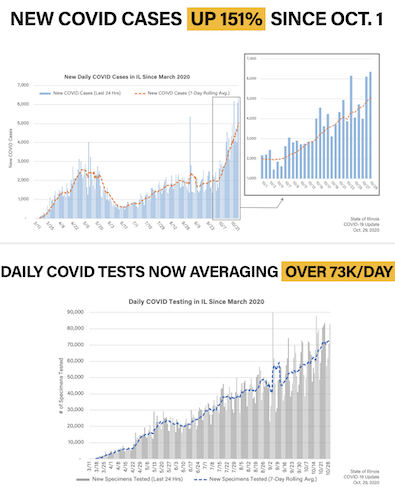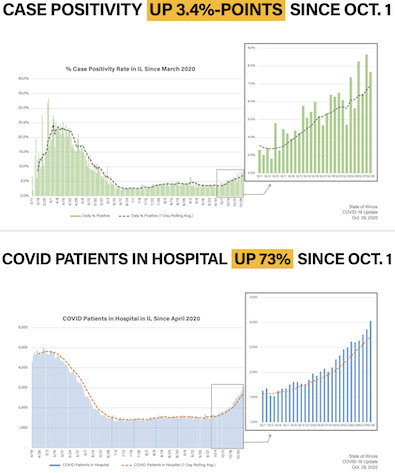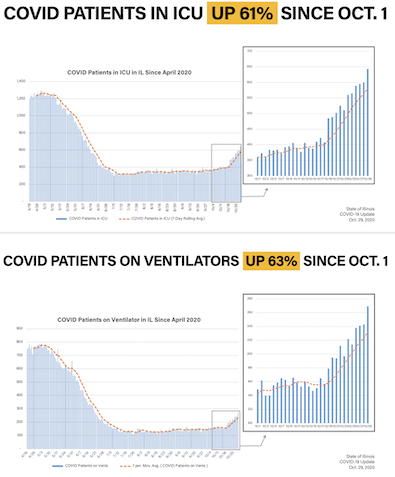* Illinois State Board of Elections…
With record-setting vote-by-mail volume in the 2020 general election, the Illinois State Board of Elections advises media and voters to be aware that unofficial vote totals reported on election night may change significantly in the two weeks to follow.
As of Nov. 2, Illinois’ 108 local election authorities reported up to 587,000 mail ballots that had not yet been returned by voters. While some of these ballots will arrive in time to be processed and included in election night reporting, many are likely to arrive after Election Day and be added to unofficial totals. Illinois allows ballots that are postmarked no later than Election Day to arrive and be counted for two weeks afterward, so totals could change through Nov. 17.
The Illinois State Board of Elections will regularly update the statewide totals for mail ballots on its website, but does not report any election results until it certifies the vote on Dec. 4. Unofficial results before certification may be obtained from local election authorities.
The following background information may be useful to news media covering election results in the two weeks to come:
• As of Nov.2, Illinois election authorities had sent 2.35 million ballots to voters and 1.76 million of those ballots had been returned by voters. (The complete report, including totals from individual election authorities, is attached following this release.)
• With 1.83 million in-person early votes cast as of Nov. 2, Illinois had cast nearly 3.6 million votes before Election Day.
• In 2016, voters cast 370,740 votes by mail and 1,520,694 in-person early votes, for a total of 1,891,434 votes cast before election day.
• Illinois has more than 8.3 million registered voters for the 2020 general election, which is an all- time record. Unofficial pre-election reports indicate that 43 percent of registered voters have already voted.
• The constitutional amendment on this year’s ballot can pass if it receives 60 percent approval from voters who vote on the question or a simple majority of affirmative votes among all ballots cast in the election. Because of this formula, the fate of the amendment may not be known on election night even when accounting for mail ballots not yet returned.
• As mail ballots arrive in the days after Nov. 3, it is likely that close races may see leads change as results are reported. Reporters should check with local election authorities for updated vote counts and make readers, viewers and listeners aware of why these numbers are changing.
• The certification schedule after Election Day is as follows:
o Nov.17:Local election authorities must complete counting of mail and provisional ballots
o Nov. 24: Local election authorities must transmit results to the State Board of Elections
o Dec. 4: State Board of Elections certifies the vote and publishes official results
• From 1976-2016, turnout in presidential elections in Illinois has averaged 73 percent. If statewide turnout for this election matches 2016’s 70.56 percent, 5.87 million votes will be cast.
• Voters needing assistance locating polling places or with other voting-related questions or concerns on Election Day can call the State Board of Elections at (217) 782-4141 or (312) 814- 6440. The Board of Elections website, elections.il.gov, will feature a special landing page for voter assistance beginning at midnight on Nov. 3.
The attachment is here.
13 Comments  
|
Everyone has their own priorities
Monday, Nov 2, 2020 - Posted by Rich Miller
* From today’s press conference…
Q: Governor, can I just ask one more question? It’s about the American flag, it’s about the American flag because there’s a man who’s a World War II vet, he’s also a Korean War vet, he wants to know why the flag is still at half-staff. I know you ordered all the municipalities to put it to half-staff in March. It’s been eight months now. When can we see it at full-staff? [crosstalk about something to do with election day]
A: We’ve lost more than three 9/11’s in nine months. More than three 9/11’s. More than 9,700 people have passed away. We are losing dozens of people every single day. So, yes, I think during this pandemic, I think until we get through this pandemic, I think it’s the right thing to do to recognize the terrible loss that so many people, who can’t even go to a funeral sometimes for a relative or a friend, this is one way that we can honor all of them.
26 Comments  
|
COVID-19 roundup
Monday, Nov 2, 2020 - Posted by Rich Miller
* Click here for a PowerPoint presentation that the governor intends to talk about today.
* Hal Dardick at the Tribune…
As Illinois finally nears its goal of employing 3,800 people to track down and warn the contacts of people infected with COVID-19, experts say that number may no longer be sufficient to help control the virus.
That’s because contact tracing — which aims to reduce disease spread by identifying and isolating people who could be infectious — works best when infection rates are relatively low. The state is seeing record numbers of daily confirmed cases.
“Contact tracing is not a silver bullet, and it can be overwhelmed very quickly with an expanding epidemic, because cases will appear and transmission will occur much more quickly than a health department can hire contact tracers,” said Crystal Watson, a senior scholar at the Johns Hopkins Center for Health Security. “So, there is kind of a threshold at which contact tracing becomes much less effective.
“And so, what we need to do in those cases is use other interventions like enforcing mask use and physical distancing and shutting down indoor areas.”
Watson is part of a team at the Johns Hopkins Center for Health Security and National Public Radio that has tracked the status of contact tracing in the United States. They concluded in a recent report that once a state is logging more than 10 new COVID-19 cases daily for every 100,000 residents, contact tracers become overwhelmed.
Illinois has quadruple that number of new cases per 100K residents.
* Beware antigen test results…
As rapid tests are becoming more widely available, delivering results in minutes in doctor’s offices, nursing homes, schools and even the White House, officials warn of a significant undercount, blurring the spread.
Officials say that antigen tests, which are faster than polymerase chain reaction (PCR) tests but less able to detect low levels of the virus, are an important tool for limiting the spread. But they caution that with inconsistent public reporting, the case undercount may worsen.
“We want to be sure that we’re not now saying, ‘there’s no disease,’ when there is lots of disease. All that’s happened is that the science with which we identify it has evolved,” said Janet Hamilton, the executive director of the Council of State and Territorial Epidemiologists, the group that helps the Centers for Disease Control and Prevention define cases of the coronavirus.
* Tribune live blog headlines…
Chicago’s jazz clubs struggle to stay afloat
National Guard arriving Monday at some Indiana nursing homes hard hit by COVID-19 cases
COVID-19 restrictions take effect in east-central Illinois
Chicago health officials urge people to get flu shots
As the pandemic wears on, more working moms are forced to quit their jobs, and the impact of the ‘shecession’ could be long-lasting
* Sun-Times live blog headlines…
Surging COVID-19 numbers spark Election Day concerns for polling places
COVID-19 recruiting tips for high school basketball players
Hospitals strain to find new nurses as COVID-19 rates rise
10 more chief judge’s employees test positive for the coronavirus, including 7 at juvenile detention building
3 Comments  
|
A look ahead
Monday, Nov 2, 2020 - Posted by Rich Miller
* I think Dan Vock is mostly right about what would happen if House Speaker Michael Madigan picks up a significant number of seats tomorrow…
It could make it easier for Democrats to legislate in the upcoming session. The COVID-19 pandemic has strained Illinois’s already precarious financial situation, and keeping the budget in the black next year could require unpopular program cuts or even tax hikes. In the past, Madigan has often sought Republican votes for political cover when passing politically contentious measures. But Republicans blame Madigan and Democrats for Illinois’s troubles already, and more Democrats in the House would give GOP lawmakers less leverage in those negotiations.
Politically, adding more Democrats in the suburbs could shore up the party’s strength at a time when Democrats have been losing seats outside of the Chicago metro area.
More Democrats in the House would give Madigan a freer hand when it comes time next year to redraw the legislative district lines for the next decade. There is widespread concern among Democrats that this year’s Census will undercount the number of residents who are Black, Hispanic, immigrants, low-income or otherwise hard to reach. If so, it would sap Democrats’ strength in legislative bodies like the Illinois House. But if Madigan’s Democrats have more territory to work with, they can cede some seats while still holding a commanding majority.
Adding Democrats to the Illinois House would also give Madigan an easier path to round up the 60 votes he needs to continue as speaker of the House. Madigan has been speaker, except for a two-year stint in the 1990s, since 1983, and it seems unlikely that he would lose that post soon. But eight House Democrats have already called for him to resign his leadership post, and another seven have said he should step down if the allegations in the ComEd corruption investigation are true. If all of them defected, Madigan presumably would only have 59 votes for speaker. Adding more Democrats to the chamber would give him more possible votes to pick up.
And this is most certainly correct…
Finally, Springfield insiders speculate that weakening the Republican caucus could also be a form of political payback by the speaker, after Republican Leader Jim Durkin initiated a process to try to remove Madigan from the House chamber over the allegations in the ComEd investigation. The power company admitted in federal court that it arranged for jobs, contracts and payoffs to people in Madigan’s circle in order to gain favor with the speaker. But federal prosecutors have not charged Madigan with a crime.
But a question that isn’t often asked is: What happens if Madigan’s gains are on the “Meh” side?
Discuss.
22 Comments  
|
|
Comments Off  
|
This reminds me of a story…
Monday, Nov 2, 2020 - Posted by Rich Miller
* One day when I was a kid, my mom dropped her (then) four sons off at Sunday school and dispatched herself to a local diner to quietly sip a cup of coffee before church.
All of a sudden, in walks her four boys who proceeded to noisily join her at her table, unceremoniously ending her rare and precious moment to herself. Unbeknownst to all of us, the time had rolled back an hour the night before and Sunday school hadn’t yet begun. So, rather than find something else to do, we decided to go hang out with our beloved mother. Thankfully, my mom has a great sense of humor and we all laughed about the mistake. No blood, no foul.
* I bring this up because I yet again forgot to change the timestamp on the blog over the weekend. I can’t really adjust it now because doing so will mess up comments, so I’ll get to it tonight.
Sorry, but it kinda runs in the family.
Also, I love you, Mom. I remember that day more than any Sunday school class I ever attended. Thanks for being you.
22 Comments  
|
* Press release…
The Illinois Department of Public Health (IDPH) today reported 6,222 new confirmed cases of coronavirus disease (COVID-19) in Illinois, including 20 additional deaths.
Champaign County: 1 male 60s
Cook County: 1 female 50s, 1 female 60s, 1 male 60s, 2 females 70s, 2 males 70s, 2 males 80s, 1 female 0ver 100
DuPage County: 1 male 80s
Iroquois County: 1 male 80s
Lake County: 1 male 80s
Mason County: 1 male 70s, 1 male 90s
Monroe County: 1 female 90s, 1 female over 100
Piatt County: 1 female 60s
Will County: 1 male 90s
Currently, IDPH is reporting a total of 423,502 cases, including 9,810 deaths, in 102 counties in Illinois. The age of cases ranges from younger than one to older than 100 years. Within the past 24 hours, laboratories have reported 68,118 specimens for a total 7,876,421. As of last night, 3,371 people in Illinois were reported to be in the hospital with COVID-19. Of those, 722 patients were in the ICU and 298 patients with COVID-19 were on ventilators.
The preliminary seven-day statewide positivity for cases as a percent of total test from October 26 – November 1 is 8.1%. This is the number that IDPH has been consistently reporting in its daily releases and is calculated using total cases over total tests. Similar to the Centers for Disease Control and Prevention, IDPH has been using test positivity for regional mitigation metrics on its website since mid-July. Test positivity is calculated using the number of COVID-19 positive tests over total tests. On October 29, 2020, IDPH began reporting the statewide test positivity in its daily releases. The preliminary seven-day statewide test positivity from October 26, 2020 – November 1, 2020 is 9.7%.
Case positivity and test positivity rate are both relevant and offer insight into the bigger COVID-19 picture. Case positivity helps us understand whether changes in the number of confirmed cases is due to more testing or due to more infections. Whereas, test positivity accounts for repeated testing and helps us understand how the virus is spreading in the population over time.
*All data are provisional and will change. In order to rapidly report COVID-19 information to the public, data are being reported in real-time. Information is constantly being entered into an electronic system and the number of cases and deaths can change as additional information is gathered. For health questions about COVID-19, call the hotline at 1-800-889-3931 or email dph.sick@illinois.gov.
* Sunday…
The Illinois Department of Public Health (IDPH) today reported 6,980 new confirmed cases of coronavirus disease (COVID-19) in Illinois, including 35 additional deaths.
Alexander County: 1 female 70s
Bureau County: 1 female 90s
Cook County: 4 females 70s, 4 males 70s, 1 female 80s, 2 males 80s, 1 female 90s, 2 males 90s, 1 male over 100
DuPage County: 1 female 80s, 1 female 90s
Henry County: 1 male 60s, 1 male 80s
Lake County: 1 female 70s, 1 female 90s
Macon County: 1 male 50s, 1 female 80s
Madison County: 1 male 70s
Montgomery County: 1 female 90s
Peoria County: 1 male 80s
Pike County: 1 male 90s
Sangamon County: 1 female 90s
Will County: 1 male 60s, 1 female 70s, 1 male 70s
Woodford County: 2 females 80s
Currently, IDPH is reporting a total of 417,280 cases, including 9,792 deaths, in 102 counties in Illinois. The age of cases ranges from younger than one to older than 100 years. Within the past 24 hours, laboratories have reported 78,458 specimens for a total 7,808,303. As of last night, 3,294 people in Illinois were reported to be in the hospital with COVID-19. Of those, 692 patients were in the ICU and 284 patients with COVID-19 were on ventilators.
The preliminary seven-day statewide positivity for cases as a percent of total test from October 25 – October 31 is 8.0%. This is the number that IDPH has been consistently reporting in its daily releases and is calculated using total cases over total tests. Similar to the Centers for Disease Control and Prevention, IDPH has been using test positivity for regional mitigation metrics on its website since mid-July. Test positivity is calculated using the number of COVID-19 positive tests over total tests. On October 29, 2020, IDPH began reporting the statewide test positivity in its daily releases. The preliminary seven-day statewide test positivity from October 25, 2020 – October 31, 2020 is 9.4%.
* Saturday…
The Illinois Department of Public Health (IDPH) today reported 7,899 new confirmed cases of coronavirus disease (COVID-19) in Illinois, including 46 additional deaths.
Adams County: 1 male 70s
Boone County: 1 male 60s
Bureau County: 1 male 80s
Carroll County: 1 male 80s
Cook County: 1 female 40s, 1 female 50s, 2 females 60s, 3 males 60s, 1 female 70s, 5 males 70s, 1 female 80s, 1 female 90s, 1 female 100+
DuPage County: 1 female 80s
Kane County: 1 male 50s, 1 male 70s, 2 females 80s, 1 female 90s
Lake County: 1 male 70s, 1 male 90s
LaSalle County: 1 female 60s
Macon County: 1 male 90s
Madison County: 1 female 80s
Marion County: 1 female 70s, 1 male 70s
Mason County: 1 male 80s, 1 female 100+
McLean County: 1 female 80s
Monroe County: 1 male 80s, 1 female 90s
Sangamon County: 1 female 80s
Vermilion County: 1 female 60s
Wayne County: 1 female 90s
Whiteside County: 1 female 70s
Will County: 1 female 60s, 1 male 80s, 1 female 90s
Winnebago County: 1 male 70s
Currently, IDPH is reporting a total of 410,300 cases, including 9,757 deaths, in 102 counties in Illinois. The age of cases ranges from younger than one to older than 100 years. Within the past 24 hours, laboratories have reported 92,636 specimens for a total 7,729,845. As of last night, 3,228 people in Illinois were reported to be in the hospital with COVID-19. Of those, 680 patients were in the ICU and 290 patients with COVID-19 were on ventilators.
The preliminary seven-day statewide positivity for cases as a percent of total test from October 24 – October 30 is 7.5%. This is the number that IDPH has been consistently reporting in its daily releases and is calculated using total cases over total tests. Similar to the Centers for Disease Control and Prevention, IDPH has been using test positivity for regional mitigation metrics on its website since mid-July. Test positivity is calculated using the number of COVID-19 positive tests over total tests. On October 29, 2020, IDPH began reporting the statewide test positivity in its daily releases. The preliminary seven-day statewide test positivity from October 24, 2020 – October 30, 2020 is 9.0%.
7 Comments  
|
* Tribune…
An hourlong virtual rally in support of a proposed state constitutional amendment to change Illinois’ income tax system to a graduated-rate tax was sidetracked Friday night by Cook County President Toni Preckwinkle delivering a lengthy pitch for State’s Attorney Kim Foxx’s reelection and for voters to reject two judges up for retention.
She only spoke about Foxx for like two minutes.
* Hannah Meisel…
In the dueling campaigns for and against Gov. JB Pritzker’s signature plan to implement a graduated income tax structure in Illinois are the echoes of past attempts at tax reform.
The players have changed and the policy proposals are different, but what remains constant are both Illinois’ underlying structural revenue imbalance and the element of mistrust of Springfield politicians.
The Nov. 3 vote to amend Illinois’ constitution and allow for a graduated income tax — instead of the flat income tax structure the state has had since 1969 — is not just the culmination of Pritzker’s three-year-long campaign for the change he vowed as a gubernatorial candidate, but also the reverberation of decades of fiscal policy and messaging.
Trips back to the 1990s, the 1970s and the 1930s may be instructive.
It’s a really good piece (of course), so go take a look. You might learn something.
17 Comments  
|
Illinois recovery barely perceptible
Monday, Nov 2, 2020 - Posted by Rich Miller
* From the Institute of Government and Public Affairs…
The U of I Flash Index in October continued its slow, steady recovery from the low point of the post-COVID-19 period. The October index went up to 95.6 from its 95.1 level in September, but the economy is still well below its strength prior to the pandemic.
The impact of the recent resurgence of the virus is not captured in the October data. “The October Flash Index obviously comes at the cusp of potential changes related to the election and the virus. We could see continued, gradual improvement, or another drop in the index, depending on the availability of a vaccine or the possibility of further mandated business closures,” said University of Illinois economist J. Fred Giertz, who compiles the monthly index for the Institute of Government and Public Affairs. “The short-term impact of the election will likely be less dramatic than many people believe since the economy has a momentum that is difficult to change.”
The Illinois unemployment rate continued its decline from 11.0 percent to 10.2 percent over the last month, but it is still 2.3 percentage points above the national level, but 6.2 percentage points below its April highpoint. After adjusting for inflation, sales and corporate tax receipts were up from the same month last year while individual income tax receipts were down slightly, continuing the pattern of last month. See the full Flash Index Archive.
The Flash Index is normally a weighted average of Illinois growth rates in corporate earnings, consumer spending and personal income as estimated from receipts for corporate income, individual income, and retail sales taxes. These are adjusted for inflation before growth rates are calculated. The growth rate for each component is then calculated for the 12-month period using data through October 31, 2020. Ad hoc adjustments have been made to deal with the timing of the tax receipts resulting from state and Federal changes in payment dates beginning in March.
Accompanying graph…

The Illinois Flash Index was stuck in the mid 90s for about two years after the 9/11 attacks. That stretch pretty much killed all the budget progress made during the previous decade and we haven’t recovered since.
4 Comments  
|
* From Saturday’s Decatur Herald & Review…
HSHS St. Mary’s Hospital and Decatur Memorial Hospital have suspended visitors for inpatient care effective Saturday due to the high number of COVID-19 cases throughout Central Illinois.
“COVID-19 is spreading throughout our community. Many people may have COVID-19, and could be contagious before they are showing symptoms,” said Dr. Raj Govindaiah, chief medical officer of Memorial Health System. “Our mission is to improve the health of the people and communities we serve, and this policy will allow us to do that.”
Exceptions will be allowed with approval in areas such as the emergency department, obstetrics, pediatrics, certain outpatient procedures and surgeries, as well as for those who may be in end-of-life care or to support a patient with an intellectual disability.
* Today’s Decatur Herald & Review…
Everyone’s East End Grill restaurant parked within the confines of Decatur Airport is now taxiing to an enviable position: it can cheerfully ignore Gov. J.B. Pritzker’s orders to shutdown indoor dining service starting Monday.
That’s because the new, stricter shut down rules for this region aimed at limiting the spread of COVID-19 don’t apply to eateries that are deemed part of essential businesses, like airports. […]
He got no arguments from his Sunday morning, post-church dining crowd. Cyndi Haynes and her husband Butch were both enjoying fried breakfasts they said tasted as good as the food’s looks and aroma suggested, and were also deeply satisfied with the attitude of their host.
The construct of that restaurant story is weird. The business has an exemption because of its location, so it doesn’t have to “ignore” anything except, of course, the growing problem at the town’s hospitals.
Anyway, maybe also send that reporter over to a hospital commissary to see what the docs have to say?
15 Comments  
|
* SJ-R…
Springfield Mayor Jim Langfelder has called for an emergency city council meeting Wednesday evening to discuss COVID-19 and the state mitigation measures that went into effect Sunday, which include the suspension of indoor dining and bar service. […]
But Langfelder — worried about the impact the shutdown could have on local restaurants — has been openly critical of the added restrictions. He has advocated in recent weeks for a “stair-step” approach that would allow indoor dining to remain open during mitigations. […]
Twenty-two restaurant owners from the county filed a lawsuit Friday in Sangamon County Circuit Court against Gov. JB Pritzker seeking relief from the order.
Others followed the governor’s order and closed for indoor service. And a new Facebook group called “Support Responsible Dining in Springfield IL” was created on Sunday to encourage people to support the businesses following Pritzker’s order. The page already has more than 300 likes as of Monday morning.
I went over this with subscribers earlier today, so I’ll just let that stand. Suffice to say that a Sangamon County judge already dealt with this issue back in May. The full list of restaurants filing the suit is here.
From the attorney general’s office…
The plaintiffs have not served the defendants or sent us a copy of what they have filed.
* Meanwhile…
The City of Springfield received a $799,000 federal CARES Act grant at the start of the COVID-19 pandemic.
Of that, $200,000 was set aside for small business grants, but to date, none of those have been distributed.
Extra community development block grants were also planned for low-interest small business loans, but Springfield Mayor Jim Langfelder said a public hearing must be held before those are acted upon. […]
Another CARES Act grant in the amount of $700,000 is also coming to Springfield, but how that money will be spent is set to be determined at a public meeting at 3:30 p.m. on Wednesday, Nov. 4, in the Municipal Building. The meeting will also be available to view over Zoom.
*** UPDATE 1 *** From the Sangamon County Department of Public Health…
There is currently a long line for COVID-19 testing in our SCDPH parking lot. Please use Singer Ave. to Shackelford Dr. (behind JC Penny) when getting in line. Any one who is in the testing line by 5:00pm will be tested today.
COVID-19 testing will also be offered tomorrow from 9:00am-5:00pm in our parking lot, 2833 South Grand Avenue East Springfield, IL 62703.
Seems bad.
*** UPDATE 2 *** I asked SIU School of Medicine for a statement about Mayor Langfelder’s comments…
This is a difficult time for public health, municipal and business leaders. We know that all groups have the health and well-being of all at the top of their priorities. We now face very difficult situations for which there are no easy choices, as we simultaneously endeavor to save lives and promote our livelihood. These issues are complex and multifactorial.
The SIU School of Medicine rejects the simplicity of a false dichotomy that pits public health against economic well-being. We can and should protect both by following the best medical and economic evidence and the public health guidelines designed to mitigate the spread of COVID-19. We urge compliance with mitigation strategies while we all engage in active, multilateral dialog between the leaders of business, government entities, academic institutions, and community organizations. Together we can strive for the best actions for our citizens and communities.”
Jerry Kruse, MD, MSPH
Dean and Provost of SIU School of Medicine
40 Comments  
|
Question of the day
Monday, Nov 2, 2020 - Posted by Rich Miller
* What are your election day plans and how are they different from previous years?
72 Comments  
|
Today’s must-read
Monday, Nov 2, 2020 - Posted by Rich Miller
* Katlyn Smith at the Daily Herald talked to several suburban medical professionals and put together a really strong story about what’s going on. It’s not nearly as long as our usual “must-reads,” but it’s no less important…
As Illinois sets another single-day record for COVID-19 infections, hospitals are preparing to feel the strain of a fall and winter surge after weeks of steadily rising patient numbers.
Some medical centers are tightening visitor restrictions. Hospital administrators are hoping they won’t have to postpone elective surgeries again. But national trends are leaving suburban hospital officials anxious.
“I am extremely worried about staff,” said Dr. Sanjeeb Khatua, chief physician executive and COVID-19 incident commander at Edward-Elmhurst Health.
Again, go read the whole thing.
* Related…
* Southern Illinois Healthcare loses one of its own front-line employees to COVID-19 as hospitalizations increase: Within days, her health rapidly declined. Her lungs collapsed and were bleeding, her liver enlarged, her kidneys shut down and she went into respiratory arrest, according to her best friend, Dottie Nikolich, of Christopher. “She suffered greatly with this,” Nikolich said.
* Dr. Anthony Fauci warns US faces ‘a whole lot of hurt’ this winter due to surging COVID-19 cases
* October Coronavirus Cases Climb In Oak Lawn - COVID-19 cases are beginning to surge in parts of suburban Cook County as the state initiates further precautions to help stop the spread.
21 Comments  
|
* To sum this up, if the Fair Tax fails and President Trump is reelected and/or the Republicans maintain control of the US Senate, and a flat tax hike can’t be achieved by early January, then the state is heading to the Fed’s window…
Illinois, the only U.S. state to borrow from the Federal Reserve, will likely have to tap the central bank again to help close its $4.1 billion deficit if federal aid doesn’t come through and voters reject a ballot measure to raise taxes on the rich, according to Governor J.B. Pritzker.
The cash-strapped state sold $1.2 billion in short-term debt in June to the Fed to help close its fiscal 2020 budget gap. While Pritzker is optimistic that stimulus will arrive at some point and voters next month will approve his signature agenda item to end Illinois’s flat income tax, he’s prepared to use the Fed’s Municipal Liquidity Facility, a lifeline for state and local governments, for a second time.
“If there is no support from the federal government or there’s no fair tax, and so given that situation, we would certainly, for some of that, we would need to go to the MLF borrowing facility, but we would also implement cuts,” Pritzker, a billionaire Democrat, said in an interview. He’s asked state agencies to submit proposals for 5 percent spending cuts this year and another 10 percent for fiscal 2022.
Illinois isn’t alone in its woes. States are facing about a $200 billion revenue shortfall from fiscal 2020 through 2022, according to Moody’s Analytics, but Illinois has little cushion. The state has more than $8 billion of unpaid bills, about $137 billion of unfunded pension liabilities, and its rainy day fund has $858,873. Its borrowing penalty is the highest among states tracked by Bloomberg, with its credit rating only one step above junk.
Thoughts?
95 Comments  
|
* Lynn Sweet…
With Illinois not in play in the presidential contest, Gov. J.B. Pritzker has emerged as one of the biggest donors to the Democratic Party of Wisconsin — in a crucial battleground state that could help tip the White House to Donald Trump or Joe Biden. […]
On the federal side, $2,256,300 to the Senate Majority PAC and various giving to help elect House Democrats: $256,300 total to Nancy Pelosi Victory Fund; $1 million to the House Majority PAC and $259,100 total to the Cheri Bustos Victory Fund. Bustos is the chair of the Democratic House political operation.
Pritzker also gave $1.5 million to Priorities USA Action, a main pro-Biden super PAC, and $721,300 to the Biden Victory Fund, which was dispersed to a variety of swing state Democratic parties.
On the state party front, Pritzker gave $250,000 to the Michigan Democratic State Central Committee and $2,525,000 to the Democratic Party of Wisconsin Federal Account.
Quentin Fulks, Pritzker’s top political adviser said, “Wisconsin is the closest battleground state in the Midwest” and Pritzker “wanted to ensure that Trump did not win there.”
Emphasis added.
27 Comments  
|
* The Hill…
The top super PAC backing House Democrats is dropping more than $1 million into a last-minute media blitz defending the chairwoman of the Democratic Congressional Campaign Committee (DCCC) in a sign that her campaign for a new term is not guaranteed.
The House Majority PAC has reported spending almost $1 million on airtime and another $30,000 on digital advertising on behalf of Rep. Cheri Bustos (D-Ill.), who heads the DCCC, according to filings made with the Federal Election Commission (FEC).
Democratic sources in Washington and Illinois said two Republican polls released earlier this month that showed Bustos only narrowly ahead of her Republican rival, attorney Esther Joy King, were catalysts for the late spending blitz. […]
“She’s calling everyone in [Democratic] politics in Illinois to make sure nothing goes sideways. Call time, Zoom fundraisers, the works,” said one Illinois Democratic strategist. “She’s spooked.”
“Washington Republicans have spent nearly $1.5 million in attack ads against Cheri because she represents a district Donald Trump won and is leading the strategy to keep the Speaker’s gavel out of Kevin McCarthy’s hands,” Denise Mousouris, Bustos’s campaign manager, said in an email.
9 Comments  
|
What’s Ken Griffin’s endgame?
Monday, Nov 2, 2020 - Posted by Rich Miller
* My Crain’s Chicago Business column…
Chicago billionaire Ken Griffin has spent $53.75 million to convince Illinoisans to reject a proposed graduated income tax this year.
Illinois currently has a flat income tax. Everyone pays the same rate, rich or poor. Gov. J.B. Pritzker campaigned heavily on increasing taxes on upper-income voters and followed through by convincing the General Assembly to put a constitutional amendment on the ballot. The billionaire Democrat has since spent $56.5 million of his own money to promote the change.
Pritzker is regularly asked about his proposal, but aside from a couple of public statements, Griffin has been quiet. So, I’ve been asking for an interview for weeks, but to no avail.
Griffin’s apparently willing to let the ads he’s paying for speak for themselves. […]
I really wanted to ask him about his endgame, though.
Griffin backed Gov. Bruce Rauner to the hilt. Rauner’s plan was to create a massive crisis in order to force serious structural change. So, is Griffin now trying to create a new crisis by shutting off a revenue stream? Is this a way to starve the budget in order to force the Democratic-controlled General Assembly to address some sort of new pension reforms?
Go read the rest before commenting, please. Thanks.
41 Comments  
|
* My weekly syndicated newspaper column…
For generations now, Chicago has had its own separate set of state laws for just about every topic under the sun. The city’s mayor is allowed to appoint the school board, Chicago has its own “working cash fund” law, the state’s mayoral veto law does not apply to the city and Chicago has a unique exemption allowing it to deduct money from worker paychecks.
From big to archaic, the list is almost endless.
So, when you’ve grown accustomed to doing it your own way for a century or so, you may start thinking you’re a special case in literally everything. And that seems to be what happened last week.
Chicago Mayor Lori Lightfoot told reporters she hoped to change Gov. J.B. Pritzker’s mind about imposing the same public health mitigations on the city as the state has imposed on several other regions, including suburban Cook County, and said the two ought to be “in lockstep” on any “new restrictions.”
The mitigations mainly involve shutting down indoor dining and booze-drinking at taverns.
The moment to address this, of course, was months ago when Pritzker laid out the new plan and the boundaries of the new public health districts. Chicago was given its own district back in mid-July (ironically, at the behest of the suburbs), but not its own rules. The city, in fact, imposed even tighter restrictions on restaurants, taverns, parks, beaches, etc. than the rest of the state, which is allowed under Pritzker plan.
But the city and the mayor have known all along that local governments cannot impose looser regulations than the state’s.
And, really, how would DuPage County respond if Chicago was given a special pass on indoor restaurant dining? Not well, I assure you. And Winnebago County denizens would be rightly upset if Chicagoans could drink inside their local taverns and they could not.
Complying with the mayor’s demands would undermine the governor everywhere else in the state. And he’s got enough of that problem as it is.
Look, we know that state mitigation works if regions stick to the program.
Why? Simple.
The Metro East area as well as the region encompassing Will and Kankakee counties both eventually worked their way out of the stricter protocols. Those successes alone should be enough to prove that the spread is slowed when indoor dining and drinking are curtailed. But coverage follows conflict, so news consumers aren’t getting that message. Instead, it’s all about disagreements between political leaders and the furious anger of the hospitality industry.
But both of those previously successful regions are now right back in mitigation. Restaurants and taverns that survived the first mitigation round are now having to go through this nightmare all over again. Businesses in first-time mitigation and those in regions about to be subjected to the limits look at their colleagues and are justly terrified for their futures.
While there’s no doubt that indoor dining, indoor tavern drinking, etc. do, indeed, spread the virus, people should be forgiven for thinking it’s unfair to put the onus completely on those specific businesses — particularly at a time when the federal government is showing absolutely zero interest in helping the businesses cope and the main complainers about Illinois’ rules (other than Lightfoot) are unwilling to vigorously demand federal action.
In order to make this more “fair” and spread out the pain instead of focusing the responsibility, everyday people would be required to do their own part.
Chicago’s contact tracing program shows that “small social gatherings” are major contributors to the spread. “(W)here we’re seeing the greatest challenges is in people’s homes, in social settings that are not public,” Lightfoot said.
But if you think people are upset about the restaurant and tavern situation, try ordering them to avoid all contact with their friends and families.
Yikes.
So, the choices are between ginning up either a horrible backlash with horrible economic consequences or a horrific and widespread public backlash that could conceivably jeopardize everything. Or let it all burn, and Pritzker is not going to do that.
So, “horrible” seems the only do-able choice.
And, make no mistake, without help from D.C., it will truly get horrible for a lot of very good people.
* Related…
* Two McHenry County judges deny separate lawsuits seeking restraining order against Pritzker’s indoor dining ban
* All 11 IDPH regions under IDPH mitigation rules as of November 4
* Springfield has distributed no small business relief grants to date
* Enforcing mitigations from Pritzker. How much power does Mayor Langfelder truly hold?
* Springfield bar, restaurant owners uncertain about future as mitigations begin Sunday
* East Peoria Will Not Enforce New COVID Restrictions, Mayor Says
18 Comments  
|
Open thread
Monday, Nov 2, 2020 - Posted by Rich Miller
* My sentiments exactly…
Keep it local, keep it polite and have some fun. Thanks.
17 Comments  
|
|
Comments Off  
|
|
Comments Off  
|
* Press release…
Governor Pritzker and the Illinois Department of Public Health (IDPH) are announcing COVID-19 resurgence mitigations will be implemented in Region 2—North-Central Illinois—beginning at 12:01 a.m. on Wednesday, November 4, 2020. The region has seen a 7-day rolling average test positivity rate of 8 percent or above for three consecutive days, which exceeds the thresholds set for establishing mitigation measures under the state’s Restore Illinois Resurgence Plan. Region 2 includes Rock Island, Henry, Bureau, Putnam, Kendall, Grundy, Mercer, Knox, Henderson, Warren, McDonough, Fulton, Stark, Marshall, Peoria, Tazwell, McLean, Woodford, Livingston, and Lasalle counties.
The administration continues to work aggressively to support small businesses impacted by the ongoing pandemic, distributing more than $55.7 million in emergency grants and assistance to Region 2 alone. Moving forward, businesses in Region 2, as well as other regions currently under additional mitigations, are receiving priority consideration for the current round of the historic Business Interruption Grants (BIG) program. To date, through BIG, a total of $95 million has been directed statewide to regions currently under mitigations or where mitigations will soon take effect. These programs are guided by an equity framework and seek to address the hardest hit communities with emergency relief dollars.
“Region 2 has now sustained an average positivity rate of 8 percent or higher for three consecutive days, meaning that now every region in Illinois will soon be operating under resurgence mitigations,” said Governor JB Pritzker. “I know that the vast majority of people in this state want to keep themselves safe, their families and children safe, their parents and neighbors and friends. I have always maintained enormous faith in the people of Illinois to do what’s right for each other. As cases, hospitalizations and deaths are rising across our state, across the Midwest and across the nation, we have to act responsibly and collectively to protect the people we love.”
“The mitigation measures soon to be implemented across the entire state of Illinois have been established to protect your health and the health of those around you,” said IDPH Director Dr. Ngozi Ezike. “These mitigation measures are not meant as a punishment, but as a way to help all of us co-exist with COVID-19 more safely.”
Mitigation measures taking effect November 4 in Region 2 include:
Bars
No indoor service
All outside bar service closes at 11:00 p.m.
All bar patrons should be seated at tables outside
No ordering, seating, or congregating at bar (bar stools should be removed)
Tables should be 6 feet apart
No standing or congregating indoors or outdoors while waiting for a table or exiting
No dancing or standing indoors
Reservations required for each party
No seating of multiple parties at one table
Restaurants
No indoor dining or bar service
All outdoor dining closes at 11:00 p.m.
Outside dining tables should be 6 feet apart
No standing or congregating indoors or outdoors while waiting for a table or exiting
Reservations required for each party
No seating of multiple parties at one table
Meetings, Social Events, Gatherings
Limit to lesser of 25 guests or 25 percent of overall room capacity
No party buses
Gaming and Casinos close at 11:00 p.m., are limited to 25 percent capacity, and follow mitigations for bars and restaurants, if applicable
These mitigations do not apply to schools or polling places.
From the onset of the pandemic, support for small businesses has been one of the central features of the Pritzker administration’s COVID-19 response. Since March, the administration has launched a menu of small business and community relief programs – with over $500 million in grants and programs launched by the Illinois Department for Economic Opportunity (DCEO), including emergency hospitality grants, a downstate small business stabilization program, Fast Track Capital, and more. For more information on programs available for businesses and communities, please visit DCEO’s website.
DCEO is also actively processing reimbursements for local governments impacted by COVID-19 via the state’s Local CURES program. Thus far, nearly $12.5 million has been awarded to governments in Region 2 to help cover the costs of the emergency response, with eligible costs including PPE and other public health expenses. All eligible governments in Region 2 can submit their certification to the department and begin submitting reimbursement requests. For more information on programs available for businesses and communities, please visit DCEO’s website.
The positivity rate in Region 2 has fluctuated in recent months, with the region currently seeing an 9.3% positivity rate as of today. While the rate was 7.7% in early September, it dropped to 5% by early October and increased again to 7.2% in late October. Region 2 has also experienced a slight uptick in hospitalizations in October after leveling off the two months prior.
In the coming days, IDPH will continue to track the positivity rate in Region 2 to determine if mitigations can be relaxed, if additional mitigations are required, or if current mitigations should remain in place. If the positivity rate averages less than or equal to 6.5% for three consecutive days, then the regions will return to Phase 4 mitigations under the Restore Illinois Plan. If the positivity rate averages between 6.5% and 8%, the new mitigations will remain in place and unchanged. If the positivity rate averages greater than or equal to 8% after 14 days, more stringent mitigations may be applied to further reduce spread of the virus.
With the final addition of Region 2, now all 11 regions have triggered one of the state’s failsafe state-action metric. By tomorrow, Regions 3, 4, 5, 6, 7, 8, and 9 will all operate under Tier 1 mitigation measures, given that these regions continue to report a 7-day rolling positivity rate above 8%. Regions 10 and 11 are operating under Tier 1 mitigations after triggering additional mitigations based on sustained increases in both positivity and hospitalization rates. Region 1 continues to operate under Tier 2 mitigation measures after seeing a rise in positivity even under the Tier 1 mitigation framework, with the highest rolling positivity average in the state.
As part of the administration’s robust response to the pandemic, the state continues to strengthen its nation-leading testing operation, given that testing remains a critical step to reduce further spread of the virus. Residents across Region 2 have been taking advantage of the readily available testing, with an increase of 35% over the past three weeks. For a more targeted approach, the state continues to provide mobile testing allowing testing to be directed toward communities most impacted by COVID-19. In Region 2, this coming week mobile testing will be deployed in Canton on Monday, Lewistown on Tuesday, Princeton on Wednesday, Macomb on Thursday, Aledo on Friday and at the Streator City Park on Saturday and Sunday. To find the nearest testing center, please visit DPH.Illinois.Gov/Testing.
IDPH will continue to work closely with local health departments in Region 2 to provide education to the public and offer information to businesses and organizations on keeping residents safe. The significance of face coverings, social distancing, and hand washing have been consistently emphasized by the administration throughout the pandemic.
The region’s average positivity rate today is 9.3 percent.
Comments Off  
|
* From the Central District of Illinois 7th…
UNITED STATES DISTRICT COURT FOR THE CENTRAL DISTRICT OF ILLINOIS SEVENTH AMENDED GENERAL ORDER 20-01
October 30, 2020
IN RE: COVID-19 PUBLIC EMERGENCY
WHEREAS the Governor of the State of Illinois has declared a public health emergency in response to the spread of COVID-19 and has subsequently placed further restrictions on some regions within the Central District of Illinois; further, the Centers for Disease Control and Prevention (CDC) and other public health authorities have advised public and private entities to take precautions to reduce the spread of the virus and set forth measures to avoid exposure. The United States District Court for the Central District of Illinois recognizes the need to take measures to effectuate these goals, while also continuing to fulfill its mission and keep both its civil and criminal court functions operating.
NOW THEREFORE, to protect the public health, reduce the size of public gatherings, and reduce any non-essential travel, the Court hereby enters this Seventh Amended General Order 20-01 to amend the directives issued in the Sixth Amended General Order 20-01 (entered on August 14, 2020), effective immediately and until January 25, 2021, or further Order of the Court as follows:
Suspension of Jury Trials
To limit the numbers of persons whose presence is required in the federal courthouses in Peoria, Springfield, Urbana and court operations in the Rock Island Division, temporarily relocated to Davenport, Iowa, all civil and criminal jury trials are suspended effective immediately and shall be rescheduled by the presiding judge to a date after January 25, 2021. The presiding judge in cases affected by this order shall enter any appropriate orders, including findings under the Speedy Trial Act, on the docket of the individual cases. The Court finds that the time period of any continuance entered from the date of this Order through January 25, 2021, as a result of this Order, shall be excluded under the Speedy Trial Act, 18 U.S.C. § 3161(h)(7)(A), as the Court finds that the ends of justice are served by taking that action outweigh the interests of the parties and the public in a speedy trial, given the need to protect the health and safety of defendants, defense counsel, prosecutors, court staff, and the public by reducing the number of persons whose presence is required for such in-person hearings.
Suspension of Public Gatherings
All public gatherings, including Naturalization Ceremonies, at the federal courthouses in Peoria, Springfield and Urbana shall be suspended during the effective period of this Order, unless specifically authorized by the Chief Judge.
All other provisions of the Sixth Amended General Order 20-01 remain in effect.
Comments Off  
|
|
Comments Off  
|
Get. Off. Facebook.
Friday, Oct 30, 2020 - Posted by Rich Miller
* My mom sent me this Facebook post that she spotted earlier today…
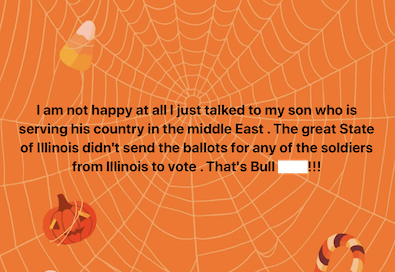
* I sent the link to the Illinois State Board of Elections and this was their response…
[Name redacted] was sent a ballot via email on Sept 16th. We’ve contacted the Rock Island County Clerk and National Guard to make sure this is resolved.
Matt Dietrich
Public Information Officer
Illinois State Board of Elections
4 Comments  
|
[The following is a paid advertisement.]
“Among all the states, Illinois jumped to the head of the pack when it comes to the environment in 2016 with its Future Energy Jobs Act, a law creating a welcoming market for installing solar energy. But because of delays in acting on a successor law to provide new funding, the solar energy industry is leaving the state in what is being called a falling off of the “solar cliff.”
Illinois is estimated to have lost close to 3,500 solar jobs already, and 1,000 more jobs could be gone by the end of the year…
Illinois has worked hard to become a leader in green energy, attracting jobs in the industry and improving the environment. The state has become an important home to businesses installing solar energy and making use of “community development” projects, in which property owners without good access to sunlight can share projects with other property owners.
Why let that industrial advantage slip away?”
Chicago Sun Times, 10/23/20 - Legislature should look at cleaner energy, criminal justice reform and pot laws in veto session
Learn more at https://www.pathto100.net/ Solar power is an affordable, local, and clean energy investment that benefits all Illinoisans.
Comments Off  
|
Question of the day
Friday, Oct 30, 2020 - Posted by Rich Miller
* Your closing argument for/against your favorite/most hated state/local candidate or ballot issue?
…Adding… As an example, Illinois Chamber CEO Todd Maisch says Illinois already has a fair income tax…
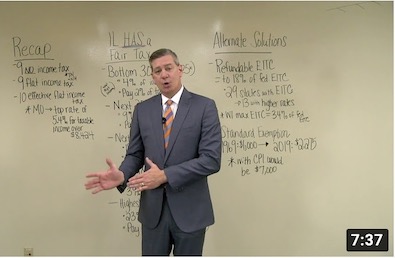
32 Comments  
|
Another day, another failed lawsuit
Friday, Oct 30, 2020 - Posted by Rich Miller
* Northwest Herald…
McHenry County Associate Judge Thomas A. Meyer dismissed a lawsuit Thursday morning filed by Nunda and McHenry townships’ road districts contending a new state law allowing local townships to be abolished through referendums is illegal under the Illinois Constitution. Attorney James Militello III, who represented the road districts in the suit, filed a notice of appeal of the decision Thursday. The lawsuit named Gov. JB Pritzker and McHenry County as defendants.
The road districts in their lawsuit argued that the state legislation in the matter, sponsored by state Rep. David McSweeney, R-Barrington Hills, and signed into law last year, was unconstitutional because it only applied to townships in McHenry County and nowhere else in Illinois. Their complaint alleged the law, which added a rule to the state’s Township Code that lets voters decide on whether to eliminate townships and their associated road districts in McHenry County through ballot measures, is “special or local legislation,” which is prohibited from being approved by the statehouse.
The law, Militello argued, only applied it to McHenry County because the law’s supporters intended to use the area as a test case for referendums seeking to abolish townships. McSweeney in a Thursday interview agreed that was the intent and said his goal was to eventually expand it to the rest of the state.
8 Comments  
|
Shenanigans! “By any means necessary”
Friday, Oct 30, 2020 - Posted by Rich Miller
* Jim Dey…
When opposing candidates accuse each other of lying, it’s a pretty fair bet they’re both telling the truth, at least partially.
Facts taken out of context or misrepresented are part and parcel of political campaigns, particularly in quick-hitting radio and television ads aimed at audience emotions.
Last week, Illinois Supreme Court candidate Judy Cates accused her opponent, David Overstreet, of being sympathetic to child molesters and hostile to victims based on a Fifth District appellate court decision that overturned a man’s conviction based on a “trial in absentia” issue.
“Trial in absentia” questions have nothing to do with being sympathetic or unsympathetic to criminals or victims.
But in an election year, who cares?
All that matters is winning — by any means necessary. […]
Overstreet voted to overturn a child molester’s conviction based on the judge’s mistaken decision to hold a trial for the defendant when the defendant was in the hospital. So Overstreet likes child molesters.
* Check out the mass text sent out in the district by a shadowy group opposing Overstreet…
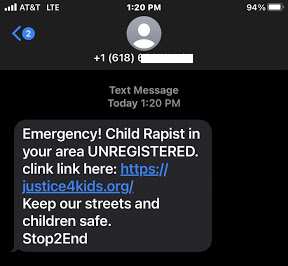
By any means necessary is right.
* Also a bit ironic considering this…
A class action lawsuit has been filed against Republican candidate for Illinois Supreme Court David Overstreet over alleged violations of the Telephone Consumer Protection Act by a lawyer who’s a top contributor to his opponent, Democrat Judy Cates..
* The Republicans were clearly caught off guard in that district…
A law firm representing the Overstreet 2020 campaign has asked a southern Illinois TV station to stop running a trial-lawyer sponsored ad it says is “disgustingly false.”
In a 30-second spot paid for by “Clean Courts Committee,” the mother of a 6-year-old who was allegedly raped says she can’t believe Judge Overstreet would let the accused “go.”
“No charges, no registering as a sex offender. Nothing,” the mother says.
The accused, Jerad Peoples, was convicted in absentia by a Marion County judge in 2017. His conviction was overturned in June at the Fifth District Appellate Court by a three-judge panel, lead by Justice Milton Wharton. The judges found that Peoples did not miss his trial date willfully but missed it because he nearly took his life and spent the day in a hospital.
Justices David Overstreet and John Barberis concurred in the decision with Wharton.
* Turns out, Judge Judy has a similar problem…
But court records show that four years ago Cates, as appellate court justice in the same court where Overstreet serves, made a very similar concurrence in the case of a Bethalto man.
Cates, Democrat, runs against Overstreet, Republican, for the seat of retiring Justice Lloyd Karmeier.
In a Nov. 22, 2016 opinion, Cates concurred with a majority to reverse the first conviction of Michael Burgund, who upon second trial was convicted of sexually assaulting his two minor daughters between the ages of one and three.
The appellate court decision that Cates concurred in, like the one Overstreet concurred in, remanded the case back to the trial court for a second trial. The second Burgund trial took place a year and a half later, in Madison County.
6 Comments  
|
Caption contest!
Friday, Oct 30, 2020 - Posted by Rich Miller
* From a reader…
These are the mailers that I’ve received since July 7th– almost non stop back and forth on Diane Pappas and Seth Lewis.
Pic…
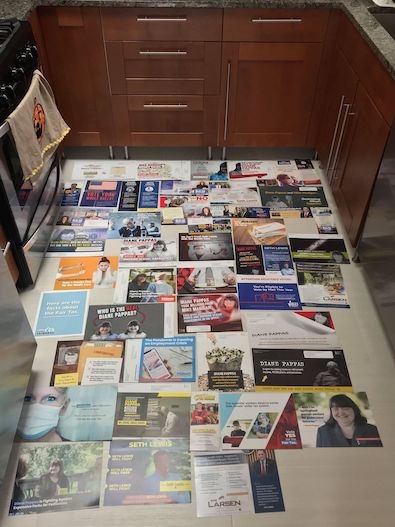
Remember, this is just one race.
41 Comments  
|
|
Comments Off  
|
* Press release…
The Illinois Department of Public Health (IDPH) today reported 6,943 new confirmed cases of coronavirus disease (COVID-19) in Illinois, including 36 additional deaths.
- Adams County: 1 male 90s
- Carroll County: 1 female 80s
- Christian County: 1 male 50s
- Cook County: 1 male 40s, 1 female 50s, 1 male 50s, 1 female 70s, 1 female 80s, 1 female 90s
- DuPage County: 1 male 60s, 1 female 70s
- Fulton County: 1 male 70s
- Greene County: 2 females 90s
- LaSalle County: 1 female 80s, 1 female 90s
- Livingston County: 1 male 60s
- Macon County: 1 female 70s
- Madison County: 1 male 70s
- McDonough County: 1 male 60s
- Morgan County: 1 male 80s
- Peoria County: 1 female 90s
- Piatt County: 1 female 90s
- Saline County: 1 female 70s, 1 female 90s
- St. Clair County: 1 male 70s
- Tazewell County: 1 male 60s
- Wayne County: 1 female 80s, 1 male 80s
- White County: 1 male 80s
- Will County: 2 males 70s, 1 female 80s, 2 females 90s
- Winnebago County: 1 female 70s
Currently, IDPH is reporting a total of 402,401 cases, including 9,711 deaths, in 102 counties in Illinois. The age of cases ranges from younger than one to older than 100 years. Within the past 24 hours, laboratories have reported 95,111 specimens for a total 7,637,209. As of last night, 3,092 people in Illinois were reported to be in the hospital with COVID-19. Of those, 673 patients were in the ICU and 288 patients with COVID-19 were on ventilators.
The preliminary seven-day statewide positivity for cases as a percent of total test from October 23 – October 29 is 7.3%. This is the number that IDPH has been consistently reporting in its daily releases and is calculated using total cases over total tests. Similar to the Centers for Disease Control and Prevention, IDPH has been using test positivity for regional mitigation metrics on its website since mid-July. Test positivity is calculated using the number of COVID-19 positive tests over total tests. On October 29, 2020, IDPH began reporting the statewide test positivity in its daily releases. The preliminary seven-day statewide test positivity from October 23, 2020 – October 29, 2020 is 8.5%.
Case positivity and test positivity rate are both relevant and offer insight into the bigger COVID-19 picture. Case positivity helps us understand whether changes in the number of confirmed cases is due to more testing or due to more infections. Whereas, test positivity accounts for repeated testing and helps us understand how the virus is spreading in the population over time.
Forty-nine counties are currently reported at a warning level – Adams, Alexander, Bond, Boone, Clark, Clay, Clinton, Coles, Crawford, Cumberland, DeKalb, Douglas, DuPage, Effingham, Ford, Franklin, Greene, Grundy, Hamilton, Henderson, Jackson, Jo Daviess, Johnson, Kane, Kendall, Knox, Lee, Macon, Marion, McHenry, Mercer, Morgan, Ogle, Perry, Pike, Randolph, Rock Island, Saline, Sangamon, Shelby, Stephenson, Wabash, Warren, Washington, Wayne, Whiteside, Will, Williamson. And Winnebago.
*All data are provisional and will change. In order to rapidly report COVID-19 information to the public, data are being reported in real-time. Information is constantly being entered into an electronic system and the number of cases and deaths can change as additional information is gathered. For health questions about COVID-19, call the hotline at 1-800-889-3931 or email dph.sick@illinois.gov.
2 Comments  
|
* The Illinois Policy Institute’s headline is about as false as false can get…
Alderman warns Pritzker could close Illinois polling places due to COVID-19
What?
Nope, nope and nope.
* Ald. Burke’s letter did not even mention the governor or the state…

* To the IPI story…
A Chicago alderman’s warning about sudden polling place closures thanks to COVID-19 orders has a Cook County commissioner asking Illinois Gov. J.B. Pritzker to reassure voters a statewide closure will not be used to impact the election.
The concern was prompted when embattled Chicago Ald. Ed Burke, 14th Ward, sent a letter to constituents urging early voting to avoid sudden Election Day closures.
“Remember, thirty percent of the polling locations in the 14th Ward have been relocated due to COVID-19. With COVID-19 on the rise, the likelihood of polling place locations closing is possible, without notice, as happened in the March election,” Burke’s letter states.
That set off Cook County Commissioner Sean Morrison, a Republican from Palos Park, who called on Pritzker to tell voters he would not issue shutdown orders for Election Day gain.
“I publicly challenge the governor to assure Illinois voters he will not interfere with the November 3rd election by proclaiming an emergency COVID shutdown similar to the one he proclaimed in March,” Morrison told Illinois Review.
Commissioner Morrison’s memory is faulty. The governor did not shut down the primary, despite pressure to do so from the far left. He also didn’t order a single polling place closure.
* But I asked anyway, and Pritzker’s spokesperson Jorday Abudayyeh said “The governor is not going to stop the election from taking place,” adding, “We have given instructions to locals on how best to conduct elections in this environment and polling places are not subject to the mitigation.”
13 Comments  
|
* WBEZ…
The boys and girls high school basketball seasons are on in Illinois, opening the door for other high contact sports to play this year — as well as potential lawsuits. […]
“IHSA may have their views of it, but school districts know what the rules are,” Pritzker said. “It’s unfortunate, but [school districts] would probably be taking on legal liability if they went ahead and moved beyond what the state had set as the mitigation standard.”
* Nexstar…
[IHSA Executive Director Craig Anderson] was asked about the risk of lawsuits the IHSA might potentially face.
“You know at some point, I think over the next month or whatever time frame we’ll figure out if this is a legal issue for us as an association or if it is for our schools and then we’ll have to pivot as we’ve been pivoting a number of times throughout this school year.”
It’s probably more about the schools. But we’ll see.
* Joliet Herald-News…
“The problem you are going to have is, even if you have parents sign waivers, if a kid gets [COVID-19] and then goes out and gives it to someone else, you have a potential of a lawsuit against the school district,” [Attorney Terry Ekl] said. “The basis of the lawsuit is they ignored the Illinois Department of Public Health and went ahead and allowed these kids to play.” […]
“There’s a proof issue involved here, but that doesn’t mean the school district is not going to get sued and have to engage in costly defensive litigation,” Ekl said. “Sometimes the cost of litigation exceeds the cost proven to be a damage. You win the case, and you still have to pay the cost of defense, which could be tens of thousands of dollars.” […]
“[Insurance carriers] may very well say to the school district, ‘If the department of public health is saying they are recommending you should not play basketball, and you go ahead and do it, we would negate your insurance coverage,’” Ekl said. “‘We’re telling you right now you should not engage in athletic activities that are in conflict with the Illinois Department of Public Health.’”
Ekl said a group of parents approached him last month about suing the IHSA. He said he researched the matter and ended up turning down the case, which was dismissed by a DuPage County judge Oct. 1.
* Les Winkeler at the Southern Illinoisan…
I covered the courthouse beat in a previous life. The lawsuit will read something like this, “Good ol’ Hometown High fielded a basketball team in the midst of a pandemic, disregarding state medical guidelines. As a result of this negligence, athletes suffered illness, resulting in death.”
And, given the strong, consistent pronouncements of state officials, that’s a difficult argument to refute.
What’s more, the Illinois State Board of Education also Tweeted that due to liability issues schools, should think carefully before plunging ahead with the basketball season.
In terms of standing up for student-athletes, I suppose you could interpret the IHSA’s actions that way. Given the fact that athletes could possibly be exposed to infected individuals by competing with students outside their circle, the organization’s response seems less heroic.
…Adding… I meant to post this and somehow forgot. Sorry…
Chicago Public Schools will likely not play basketball this winter. The CPS sent a memo to schools on Thursday announcing that girls and boys high school and elementary school basketball is postponed until further notice and possibly moved to the spring or summer of 2021.
“While the Illinois High School Association has not removed high school basketball from its winter sports calendar, [Gov. J.B. Pritzker] and [the Illinois Department of Public Health] have determined that basketball presents a greater risk of COVID-19 transmission and is not safe to play this winter,” the email from CPS said.
61 Comments  
|
* Press release…
Governor Pritzker and the Illinois Department of Public Health (IDPH) are announcing COVID-19 resurgence mitigations will be implemented in Region 6—East-Central Illinois—beginning at 12:01 a.m. on Monday, November 2, 2020. The region has seen a 7-day rolling average test positivity rate of 8 percent or above for three consecutive days, which exceeds the thresholds set for establishing mitigation measures under the state’s Restore Illinois Resurgence Plan. Region 6 includes Iroquois, Ford, Dewitt, Piatt, Champaign, Vermillion, Macon, Moultrie, Douglas, Edgar, Shelby, Coles, Cumberland, Clark, Fayette, Effingham, Jasper, Crawford, Clay, Richland, and Lawrence counties.
The administration continues to provide relief for small businesses impacted by the ongoing pandemic, distributing more than $32 million in emergency grants and assistance to Region 6 alone. Moving forward, businesses in Region 6, as well as other regions currently under additional mitigations, will receive priority consideration for the current round of the historic Business Interruption Grants (BIG) program. To date, through BIG, more than $42 million has been directed to regions currently under mitigations or where mitigations will soon take effect. These programs are guided by an equity framework and seek to address the hardest hit communities with emergency relief dollars.
“As of this morning, Region 6 has now sustained an average positivity rate of 8 percent or higher for three days, today hitting 8.6 percent – meaning that, starting Monday, they will join the majority of the state in operating under resurgence mitigations,” said Governor JB Pritzker. “With community transmission rates on the rise all around our state, it’s more important than ever to take caution, mask up, avoid gatherings and ensure your family gets through this as safe as can be. Let’s remember that the quickest way we get kids back into schools and businesses open and workers employed is to bring down infections, positivity rates, and hospitalizations in our communities – and that means mask up, wash up, back up, and sleeve up to get your flu shot.”
“We are on the precipice of the entire state entering into mitigation,” said IDPH Director Dr. Ngozi Ezike. “These last few regions have seen rapid increases in test positivity, one right after another, because of increasing disease spread throughout our communities. We need all people to adhere to both the community mitigation measures and well as personal and family measures so we can swiftly turn our entire state around.”
Mitigation measures taking effect November 2 in Region 6 include:
Bars
No indoor service
All outside bar service closes at 11:00 p.m.
All bar patrons should be seated at tables outside
No ordering, seating, or congregating at bar (bar stools should be removed)
Tables should be 6 feet apart
No standing or congregating indoors or outdoors while waiting for a table or exiting
No dancing or standing indoors
Reservations required for each party
No seating of multiple parties at one table
Restaurants
No indoor dining or bar service
All outdoor dining closes at 11:00 p.m.
Outside dining tables should be 6 feet apart
No standing or congregating indoors or outdoors while waiting for a table or exiting
Reservations required for each party
No seating of multiple parties at one table
Meetings, Social Events, Gatherings
Limit to lesser of 25 guests or 25 percent of overall room capacity
No party buses
Gaming and Casinos close at 11:00 p.m., are limited to 25 percent capacity, and follow mitigations for bars and restaurants, if applicable
These mitigations do not apply to schools or polling places.
From the onset of the pandemic, support for small businesses has been one of the central features of the Pritzker administration’s COVID-19 response. Since March, the administration has launched a menu of small business and community relief programs – with over $500 million in grants and programs launched by the Illinois Department for Economic Opportunity (DCEO), including emergency hospitality grants, a downstate small business stabilization program, Fast Track Capital, and more. For more information on programs available for businesses and communities, please visit DCEO’s website.
DCEO is also actively processing reimbursements for local governments impacted by COVID-19 via the state’s Local CURES program. Thus far, nearly $5 million has been awarded to governments in Region 6 to help cover the costs of the emergency response, with eligible costs including PPE and other public health expenses. All eligible governments in Region 6 can submit their certification to the department and begin submitting reimbursement requests. For more information on programs available for businesses and communities, please visit DCEO’s website.
Region 6 is currently seeing an 8.6% positivity rate, an increase from 5.2% in mid-September, a summer peak of 6.2% over Labor Day weekend, and a low of 1.1% in late-June. While nearly every region is seeing sustained increases in both positivity and hospitalization rates, today the COVID-related hospital admissions in Region 6 have tripled since mid-September now averaging 18 admissions per day.
In the coming days, IDPH will continue to track the positivity rate in Region 6 to determine if mitigations can be relaxed, if additional mitigations are required, or if current mitigations should remain in place. If the positivity rate averages less than or equal to 6.5% for three consecutive days, then the regions will return to Phase 4 mitigations under the Restore Illinois Plan. If the positivity rate averages between 6.5% and 8%, the new mitigations will remain in place and unchanged. If the positivity rate averages greater than or equal to 8% after 14 days, more stringent mitigations may be applied to further reduce spread of the virus.
Every region is being closely monitored since as of today, including Region 6, a total of ten of the state’s 11 regions have triggered one of the state’s failsafe state-action metric. Regions 3, 4, 5, 7, 8, and 9 will all operate under Tier 1 mitigation measures by the end of this weekend, given that these regions continue to report a 7-day rolling positivity rate above 8%. Regions 10 and 11 are now operating under Tier 1 mitigations after triggering additional mitigations based on sustained increases in both positivity and hospitalization rates. Region 1 is currently operating under Tier 2 mitigation measures after continuing to see a rise in positivity even under the Tier 1 mitigation framework, with the highest rolling positivity average in the state.
As part of the administration’s robust response to the pandemic, the state continues to strengthen its nation-leading testing operation. Today, Illinois reported a record high of 95,111 tests in a single day. The administration is building upon this groundbreaking progress, given that testing remains a critical step to reduce further spread of the virus. For a more targeted approach, the state provides mobile testing allowing testing to be directed toward communities most impacted by COVID-19. In Region 6, mobile testing has been deployed in Richland County today, in Effingham on Sunday, and in Macon at the Decatur Civic Center from today through Sunday. Next week, Region 6 will have a testing site from November 2 through November 8 at the Danville Area Community College. To find the nearest testing center, please visit DPH.Illinois.Gov/Testing.
IDPH will continue to work closely with local health departments in Region 6 to provide education to the public and offer information to businesses and organizations on keeping residents safe. The significance of face coverings, social distancing, and hand washing have been consistently emphasized by the administration throughout the pandemic.
A full list of mitigation measures pertaining to some businesses and industries may be found
*** UPDATE *** The entire state will likely be in mitigation in a few days…
6 Comments  
|
* WCIA…
Lab tests from wells near Nicor Gas’ oldest underground natural gas storage facility detected alarming levels of benzene, a chemical known to cause cancer.
In a violation notice issued in December 2019, the Illinois Environmental Protection Agency alleged the state’s largest natural gas company broke the law and threatened the quality of groundwater when it dumped the carcinogenic wastewater into the soil.
Federal safety standards set the limit of benzene at five parts per billion. According to lab tests obtained in a Target 3 investigation, the benzene found in eight Nicor Gas wells exceeded federal safety standards for three consecutive months. One test conducted in February of 2019 detected 26,000 parts of benzene per billion, an astounding 5,200 times higher than legally allowed.
In an emailed statement, the company said it discovered benzene during regular monthly testing and reported it immediately the state’s environmental regulators.
“Nicor Gas and the IEPA have been unable to identify the source of the benzene,” spokeswoman Jennifer Golz wrote on Wednesday. “Benzene is not a chemical that we use in our processes.”
According to the Centers for Disease Control and Prevention, benzene “is a natural part of crude oil, gasoline,” and is a widely produced industrial chemical often associated with underground storage sites.
Gas companies like Nicor, a subsidiary of Southern Company Gas, routinely pipe fracked gas in from out of state before storing it deep underground in naturally occurring aquifers. Industry experts say the chemical liquids used in hydraulic fracturing are often kept secret as proprietary information, but several health studies and news reports have documented widespread use of benzene in fracking fluids
Go read the whole thing. Crazy.
*** UPDATE *** Nicor…
Hello Rich,
I saw your mention of the WCIA article about Nicor Gas, and I wanted to let you and your readers know that this downstate television station did not attempt to factcheck its reporting, nor has made the factual corrections Nicor Gas has requested. Therefore, I am reaching out to you directly to ensure you know that all Nicor Gas storage facilities are safe and in compliance with local, state and federal environmental standards and guidelines.
WCIA is presenting factually inaccurate information about the operation of our storage facilities in a misleading and irresponsible manner that alarms those in our state who rely on Nicor Gas to keep their families safe, homes warm and businesses running.
There are several inaccuracies in the WCIA report including assertions that Nicor Gas “dumped” contaminated water without regard. All produced water was discharged legally in seepage fields permitted by the Illinois Environmental Protection Agency for more than 20 years. The presence of benzene was not identified in any of the company’s routine monitoring and analytical tests until 2018. Nicor Gas was first to detect the benzene, and we immediately reported this to the IEPA and implemented proactive corrective actions to stop benzene discharge, including disposal of the produced water in appropriate and permitted disposal facilities.
It’s important to note, as we have also shared with WCIA, that benzene is not used by Nicor or in natural gas operations. Its presence is not an effect of our work or processes.
The source of the benzene is still unknown. However, as soon as it was identified, Nicor Gas immediately shut in the extraction well where benzene was detected despite the challenges it would present to operations and distributing natural gas to our customers during the winter heating season. These events were happening during the same time as last year’s Polar Vortex. Without the added capacity of our underground storage, more than 700,000 customers would have been without heat during the dangerously cold temperatures.
If you’d like to learn more about how our storage ensures we are able to safely and reliability meet the energy needs of Illinoisans, I encourage you to visit https://www.nicorgas.com/storage.
Thank you for your time and consideration to help set the record straight.
Jennifer
Jennifer Golz
Manager, PR & Media Relations
Corporate Communications
14 Comments  
|
* Finke…
Rep. Mike Murphy, R-Springfield, a former restaurant owner, said during a briefing with state health officials Thursday that lawmakers were told private gatherings and universities pose a bigger transmission problem than bars and restaurants. He, too, wants to see the data Pritzker is using to determine the mitigations.
Pritzker has said that information will be made available early next week. He said it’s taken time to compile records from nearly 100 separate local health agencies.
Murphy said if “it proved to be that restaurants and bars were the reason why we cannot control the spread of this, yes I would (support the mitigations). But I haven’t seen that proved, and I’m not sure they have it.”
“There has been no data that says there has been an outbreak linked to bars and restaurants,” Bourne added.
* I told subscribers about this earlier today, but it’s important enough that I think we should go over it here now. This IDPH data is for Region 3 (which includes Springfield) through a couple weeks ago. Expect an update very soon…
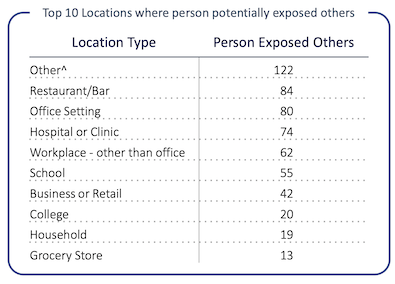
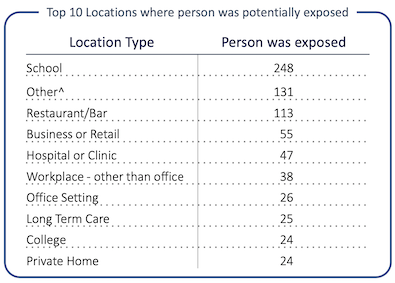
“Other”…
‘Other’ means locations not selected from the 37 standard locations available to the contact tracing workers. These locations include vacation, frat house, library, fire department and a variety of other venues and may include non- responses.
As you may recall, Rep. Tim Butler, who was also at yesterday’s HGOP press conference, said he had no idea how he caught the COVID. He’s therefore an “other.”
* Dr. Ezike yesterday…
There’s exposure data, and then there’s outbreak data. Those are two different pieces of data that are collected.
As the governor explained, the outbreak data will be where all of these individuals in the same space and time were diagnosed as cases and they’re connected to one another clearly. There’s a connection like ‘I was with you. And I developed symptoms, we were in this space,’ and these people were all connected. So that could be at a fraternity party, that could be at a wedding. Those were clearly identified outbreaks.
Most people who end up contracting the infection don’t know exactly who they got it from. They don’t say, ‘Oh, I was with so and so who was positive, that’s where I got it’. If they don’t have any idea of who they got it from, then that’s when you go into the contact tracing, in terms of identifying places that they were in the time that you would have contracted the virus.
And so from that data that you collect from all these people who were just like, ‘Well, I was here, I was there,’ it is consistent that where those people recollect that they were in the time, were bars and restaurants. Obviously, if people were in school, they will say school people who were at work will say work.
So, we already told you we’re not the ones who are going to be closing school, we’re not going to tell people not to go to work. We have to operate in the place that we can operate. And there you have, sitting there, bars and restaurants coming up time after time in the exposure sites that people were before they contracted the virus.
…Adding… IDPH Region 3…
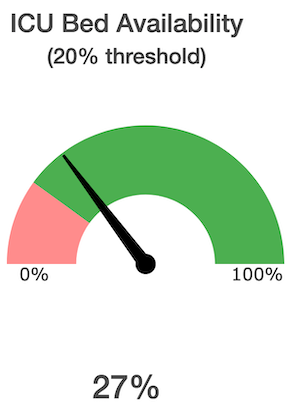
And from Sangamon County…
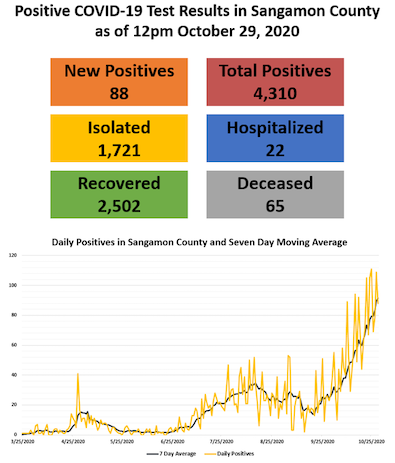
But, yeah. Go hang out in a crowded indoor tavern.
60 Comments  
|
Shenanigans!
Friday, Oct 30, 2020 - Posted by Rich Miller
* People should either get off Facebook or unfollow goofs like this…
23 Comments  
|
Today’s must-read
Friday, Oct 30, 2020 - Posted by Rich Miller
* NBC 5…
A Chicago doctor took the podium during Thursday’s coronavirus press briefing to ‘set some facts straight’ on misinformation being spread amid a surge in coronavirus cases across Illinois.
Dr. Emily Landon, an infectious disease expert at University of Chicago Medicine, told media while she’s worried about the record high 6,363 coronavirus cases set on Thursday, she’s also worried about ‘misinformation and fatigue’ that she says has grown across the state.
“Today, I want to set some facts straight,” Landon began. “First of all, inconsistent recommendations are not evidence of a conspiracy, nor are inconsistent data. They’re evidence of a changing knowledge and epidemiology.” […]
“In different situations, different metrics mean different things,” Landon said. “For example, when testing rates are low or changing rapidly, the test positivity rate may not mean quite the same thing as when testing rates are stable, or when the testing rates aren’t increasing as much as the cases.” […]
“There are new data coming out every day. Science is learning,” Landon assured. “We change our guidance, because we learn something new. Changing advice should make you feel good that we’re making progress.”
* KMOX…
There has been widespread disagreement about the ban on indoor dining in the Metro East, and other places in Illinois. Dr. Landon said the last time the ban was imposed, it worked in stopping the increase in positivity rates.
Yep.
* Another NBC 5 story…
As temperatures cool down, more people have moved to dining indoors, which Landon said is a major spreading spot of the coronavirus. She said “there’s no way around” Gov. J.B. Pritzker’s recent order to shut down indoor bar service and dining in most regions in Illinois.
“Over 100 (coronavirus) cases were linked to one bar in Michigan in a week. And over the summer in Minnesota, 29 bars and restaurants started clusters that spread throughout the community” Landon said. “Shutting down bars and restaurants and putting in mass mandates changed the trajectory of the pandemic in Arizona, Texas, Florida, San Diego, Washington, DC, Illinois, I could go on.”
Officials said the major issue with bars and restaurants is the need to remove a mask in order to eat or drink, which could lead to a further spread of the coronavirus.
Landon said the spreading is not the fault of any particular restaurant, but rather that the spread is inevitable. She reminded that people with the coronavirus are contagious before experiencing symptoms.
“The reality is, that restaurant can be perfectly safe from 6 to 8 p.m. and become a super spreader event from 8 to 10,” Landon said. “It all depends on whether or not someone with COVID walks in the door.”
* AP…
Dr. Emily Landon, a medical director at the University of Chicago’s medical school, said two factors facilitate the virus’s spread in winter, especially at restaurants: Colder air is drier, and the droplets that transmit the virus become even smaller.
Add to that, she said, what people do in a bar or restaurant.
“There are only a couple activities where you have to take your masks off around other people, and that is dining in a restaurant and going to a bar,” Landon noted. “There is just no way to escape the risks (of COVID-19) when you go into a restaurant.”
* ABC 7…
New data comes in every day as science continues to learn, Landon said, which can lead to disagreements, but disagreements are a normal part of the scientific process.
“We change our guidance because we learn something new,” she explained. “Changing advice should make you feel good about our making progress. Disagreement is a normal part of every process, and there is no right way to handle a new pandemic. But we’re all in the same boat and we should try to row in the same direction as much as possible.” […]
Landon said studies have found that indoor ventilation in most buildings is not enough to prevent COVID-19 transmission without masks. That is one of the reasons bars and restaurants carry a higher risk of transmission; it’s not possible to eat and drink while wearing a face covering.
* WGN TV…
The governor said his decisions were guided by models done by research experts which show when we might see spikes, including one developed by University of Chicago scientist Sarah Cobey.
While she wasn’t available for an interview Thursday, Cobey was recently quoted in the downstate Belleville News-Democrat questioning the governor’s reliance on the positivity rate.
“I have been very critical of their use of this metric and basically almost all of the metrics they’ve proposed so far because they are not scientifically founded,” the paper quoted Cobey as saying. “They’re roughly right, but they’re not metrics you want to hang your hat on.”
In the article, Cobey argues the metric is only useful if there is enough testing happening in a region. A high positivity rate in an area which averages very few tests may not be indicative of how widespread the virus has become.
During Thursday’s daily coronavirus briefing, University of Chicago Dr. Emily Landon praised Cobey as a world-class scientist, but said the governor makes his decisions based on a variety of information.
“In a pandemic, no one has a monopoly on expertise,” Landon said.
Take some time today and read Dr. Landon’s entire address.
26 Comments  
|
* Tribune…
Thirty-seven restaurants and bars in McHenry County filed suit Thursday against Gov. J.B. Pritzker and health officials, trying to prevent enforcement of an order to shut down indoor service, which is meant to prevent the spread of the coronavirus.
A hearing was set in the matter for Friday, one day before the shutdown was scheduled to take place in Lake and McHenry counties. A similar order has been imposed in Cook, DuPage, Kane, Kankakee and Will counties, and other parts of Illinois. […]
He based the legal challenge in part on the state law that gives the governor power to issue executive orders in an emergency, as Pritzker first did in March, but limits that power to 30 days. Some courts previously have upheld the governor’s power to issue consecutive orders to extend that time period indefinitely, but a downstate judge ruled this summer that the governor may not do so, a case that the state is also appealing.
* Pioneer Press…
Five Park Ridge restaurant owners filed a lawsuit this week against Gov. J.B. Pritzker, objecting to the governor’s latest order shutting down indoor dining at bars and restaurants.
The lawsuit, filed in Cook County Circuit Court late Wednesday, claims Pritzker lacks the authority to issue the executive order because the emergency powers he used to issue it expired in April.
Just a ridiculous assertion.
*** UPDATE 1 *** Sam Toia of the Illinois Restaurant Association announced today that his group will develop a standard amicus brief so that it can weigh in on lawsuits as they are filed.
*** UPDATE 2 *** Welp…
A McHenry County judge denied a temporary restraining order Friday filed by 37 local bars and restaurants can remain open despite the governor’s mitigation rules that take effect Saturday.
Attorneys met Friday morning at the McHenry County courthouse in Woodstock, where they argued primarily about Illinois Gov. JB Pritzker’s powers or lackthereof to enforce consecutive 30-day executive orders.
McHenry County Judge Thomas Meyer said that he ruled that way because he felt that the new mitigation orders were based on new facts and were not simply an extension of Pritzker’s original executive order.
*** UPDATE 3 *** The attorney general’s office tells me that judges in DuPage and Cook counties today also denied TRO motions filed by restaurant plaintiffs.
36 Comments  
|
Open thread
Friday, Oct 30, 2020 - Posted by Rich Miller
* Keep it local, keep it polite and keep my thanks in your heart.
25 Comments  
|
|
Comments Off  
|
Shenanigans!
Thursday, Oct 29, 2020 - Posted by Rich Miller
* I know it’s Oak Park, and I know this may look innocuous because it’s the LWV and all…
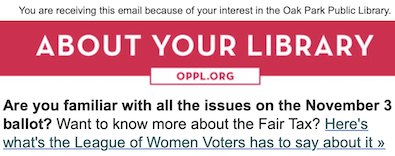
But if you click the link, you’re taken to this page…
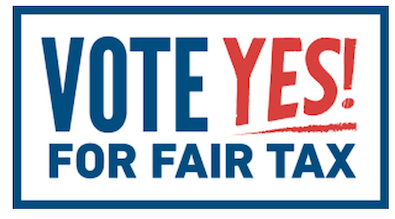
Not good.
Also, you’re a public library. Proofread your copy.
Seeing any other foul play or dirty pool out there?
17 Comments  
|
Question of the day
Thursday, Oct 29, 2020 - Posted by Rich Miller
* My initial, private reaction to this announcement would not be allowed on this website…
* The Question: Your own thoughts?
88 Comments  
|
* Three days in a row of a positivity rate at or above 8 percent leads to IDPH mitigation, and Region 3 has hit that point. The region runs from eastern Sangamon County over to the Mississippi River and as far south as Calhoun County.
* Press release…
The Illinois Department of Public Health (IDPH) today reported 6,363 new confirmed cases of coronavirus disease (COVID-19) in Illinois, including 56 additional deaths.
- Adams County: 1 male 70s
- Christian County: 1 male 80s
- Clark County: 1 female 80s
- Clay County: 1 female 70s
- Clinton County: 1 female 90s, 1 male 90s
- Cook County: 1 male 40s, 3 females 60s, 1 male 60s, 1 female 70s, 1 male 70s, 1 female 80s, 2 males 80s, 1 female 90s, 2 males 90s
- DeKalb County: 1 male 80s
- DuPage County; 1 female 40s, 1 female 80s
- Edgar County: 1 male 70s
- Ford County: 1 female 70s
- Kane County: 2 males 60s, 1 female 70s
- Lake County: 1 female 80s, 2 females 90s, 1 male 90s
- LaSalle County: 2 females 90s
- Livingston County: 1 female 70s
- Macon County: 1 male 30s
- Marion County: 1 male 70s, 1 female 80s, 1 male 80s
- McDonough County: 1 male 60s
- Morgan County: 1 male 60s
- Ogle County: 1 male 60s
- Rock Island County: 1 male 70s, 1 female 90s
- St. Clair County: 1 female 60s, 1 female 80s
- Tazewell County: 1 male 70s, 1 male 90s
- Wabash County: 1 male 70s
- Wayne County: 1 male 90s
- Will County: 1 male 70s, 1 female 80s, 2 males 80s
- Winnebago County: 1 male 70s, 1 male 80s, 1 male 90s
Currently, IDPH is reporting a total of 395,458 cases, including 9,675 deaths, in 102 counties in Illinois. The age of cases ranges from younger than one to older than 100 years. Within the past 24 hours, laboratories have reported 83,056 specimens for a total 7,542,098. As of last night, 3,030 people in Illinois were reported to be in the hospital with COVID-19. Of those, 643 patients were in the ICU and 269 patients with COVID-19 were on ventilators.
The preliminary seven-day statewide positivity for cases as a percent of total test from October 22 – October 28 is 6.9%. This is the number that IDPH has been consistently reporting in its daily releases and is calculated using total cases over total tests. Similar to the Centers for Disease Control and Prevention, IDPH has been using test positivity for regional mitigation metrics on its website since mid-July. Test positivity is calculated using the number of COVID-19 positive tests over total tests. Beginning October 29, 2020, IDPH is reporting the statewide test positivity in its daily releases. The preliminary seven-day statewide test positivity from October 22, 2020 – October 28, 2020 is 8.2%.
Case positivity and test positivity rate are both relevant and offer insight into the bigger COVID-19 picture. Case positivity helps us understand whether changes in the number of confirmed cases is due to more testing or due to more infections. Whereas, test positivity accounts for repeated testing and helps us understand how the virus is spreading in the population over time.
*All data are provisional and will change. In order to rapidly report COVID-19 information to the public, data are being reported in real-time. Information is constantly being entered into an electronic system and the number of cases and deaths can change as additional information is gathered. For health questions about COVID-19, call the hotline at 1-800-889-3931 or email dph.sick@illinois.gov.
…Adding… Press release…
Governor Pritzker and the Illinois Department of Public Health (IDPH) are announcing COVID-19 resurgence mitigations will be implemented in Region 3—West-Central Illinois—beginning at 12:01 a.m. on Sunday, November 1, 2020. The region has seen a 7-day rolling average test positivity rate of 8 percent or above for three consecutive days, which exceeds the thresholds set for establishing mitigation measures under the state’s Restore Illinois Resurgence Plan. Region 3 includes Hancock, Adams, Pike, Calhoun, Jersey, Greene, Scott, Brown, Schuyler, Cass, Morgan, Macoupin, Montgomery, Christian, Sangamon, Logan, Menard, and Mason counties.
The administration continues to provide relief for small businesses impacted by the ongoing pandemic. Today, the administration announced that through both the historic Business Interruption Grants (BIG) program and Local CURE funding, a total of $94 million has already been deployed to Illinois businesses and communities to help offset costs and losses due to the pandemic. In Region 3 alone, nearly $40 million in emergency grants and assistance has been awarded via both programs. Moving forward, businesses in Region 3, as well as other regions currently under additional mitigations, will receive priority consideration for the current round of BIG. These programs are guided by an equity framework and seek to address the hardest hit communities with emergency relief dollars.
“As of this morning, Region 3 – which encompasses Quincy, Springfield and much of West-Central Illinois – has now sustained an average positivity rate of 8 percent or higher for three days, today hitting 8.8 percent – meaning that, starting Sunday, they will join the majority of the state in operating under resurgence mitigations,” said Governor JB Pritzker. “Something has got to give, and these mitigations aim to cut down on those high-risk activities until we bring down the positivity rate in an area once again. Because let’s be clear: well-meaning and reasonable people can have fair disagreements about how and where to draw lines and connect dots – but when every single metric in every single corner of the state is trending poorly, we have to take meaningful action to keep our people safe.”
“This is the first time a central Illinois region has needed to implement mitigation measures because of increasing positivity,” said IDPH Director Dr. Ngozi Ezike. “For those residents living in regions and communities where the virus didn’t seem to be ‘that bad,’ things are changing with positivity rates steadily increasing. We’ve seen regions move into and then out of mitigation, so we know the measures work. The more people adhere to the measures, the quicker we can move out of mitigation.”
Mitigation measures taking effect November 1 in Region 3 include:
Bars
No indoor service
All outside bar service closes at 11:00 p.m.
All bar patrons should be seated at tables outside
No ordering, seating, or congregating at bar (bar stools should be removed)
Tables should be 6 feet apart
No standing or congregating indoors or outdoors while waiting for a table or exiting
No dancing or standing indoors
Reservations required for each party
No seating of multiple parties at one table
Restaurants
No indoor dining or bar service
All outdoor dining closes at 11:00 p.m.
Outside dining tables should be 6 feet apart
No standing or congregating indoors or outdoors while waiting for a table or exiting
Reservations required for each party
No seating of multiple parties at one table
Meetings, Social Events, Gatherings
Limit to lesser of 25 guests or 25 percent of overall room capacity
No party buses
Gaming and Casinos close at 11:00 p.m., are limited to 25 percent capacity, and follow mitigations for bars and restaurants, if applicable
These mitigations do not apply to schools or polling places.
From the onset of the pandemic, support for small businesses has been one of the central features of the Pritzker administration’s COVID-19 response. Since March, the administration has launched a menu of small business and community relief programs – with over $500 million in grants and programs launched by the Illinois Department of Commerce and Economic Opportunity (DCEO), including emergency hospitality grants, a downstate small business stabilization program, Fast Track Capital, and more. For more information on programs available for businesses and communities, please visit DCEO’s website.
DCEO is also actively processing reimbursements for local governments impacted by COVID-19 via the state’s Local CURES program. To date, more than $8.5 million has been awarded to governments in Region 3 to help cover the costs of the emergency response, with eligible costs including PPE and other public health expenses. All eligible governments in Region 3 can submit their certification to the department and begin submitting reimbursement requests. For more information on programs available for businesses and communities, please visit DCEO’s website.
Region 3 is currently seeing an 8.8 percent positivity rate, an increase from 4.6 percent in September, a summer peak of 6.2 percent in August, and a low of 0.9 percent in June. While most regions are seeing sustained increases in both positivity and hospitalization rates, today Region 3 is experiencing triple the amount of COVID-related hospital admissions since early September.
In the coming days, IDPH will continue to track the positivity rate in Region 3 to determine if mitigations can be relaxed, if additional mitigations are required, or if current mitigations should remain in place. If the positivity rate averages less than or equal to 6.5% for three consecutive days, then the regions will return to Phase 4 mitigations under the Restore Illinois Plan. If the positivity rate averages between 6.5% and 8%, the new mitigations will remain in place and unchanged. If the positivity rate averages greater than or equal to 8% after 14 days, more stringent mitigations may be applied to further reduce spread of the virus.
As of today, including Region 3, a total of nine of the state’s 11 regions have triggered one of the state’s failsafe state-action metric. Regions 4, 5, 7, 8, and 9 will all soon operate under Tier 1 mitigation measures given that these regions continue to report a 7-day rolling positivity rate above 8 percent. By tomorrow, Regions 10 and 11 will both operate under Tier 1 mitigations given that these regions triggered additional mitigations based on sustained increases in both positivity and hospitalization rates. Region 1 is currently operating under Tier 2 mitigation measures after continuing to see a rise in positivity, even under the Tier 1 mitigation framework, with the highest rolling positivity average in the state.
As part of the administration’s robust response to the pandemic, the state continues to strengthen its nation-leading testing operation, given that testing remains a critical step to reduce further spread of the virus. Testing is readily available throughout Illinois, with the state now averaging more than 72,000 tests per day. For a more targeted approach, the state provides mobile testing allowing testing to be directed toward communities most impacted by COVID-19. In Region 3, mobile sites will be at the Sangamon County Health Department this weekend. To find the nearest testing center, please visit DPH.Illinois.Gov/Testing.
IDPH will continue to work closely with local health departments in Region 3 to provide education to the public and offer information to businesses and organizations on safe ways to reopen. The significance of face coverings, social distancing, and hand washing have been consistently emphasized by the administration throughout the pandemic.
A full list of mitigation measures pertaining to some businesses and industries may be found on the DCEO website at www.dceocovid19resources.com/restore-illinois.
28 Comments  
|
Gaming Board botches yet another rollout
Thursday, Oct 29, 2020 - Posted by Rich Miller
* The Gaming Board badly botched the rollout of video poker. And now…
Developers and mayors vying for the chance to break ground on new casinos — including two in Chicago’s suburbs — will have to wait at least another six months to find out if they’re holding a winning hand.
Illinois Gaming Board administrator Marcus Fruchter blamed the COVID-19 pandemic for pushing back his agency’s timeline for handing out the first round of casino licenses as part of Gov. J.B. Pritzker’s massive statewide gambling expansion.
“Like all government agencies and private businesses, the board’s work has been impacted by COVID-19,” Fruchter said at a special Gaming Board meeting held virtually Thursday. “This is not an excuse or a crutch. It is simply a recognition of the realities that work and life are different in a global pandemic.” […]
Under state law, the Gaming Board was required to issue new licenses within a year or else give a written explanation for the holdup.
This isn’t like cannabis where the government was dealing with a brand new industry and was flooded with applications. They have zero excuses.
24 Comments  
|
* Ameya Pawar and Ted Cox…
According to the Federal Deposit Insurance Corp., over 80 million Americans are underbanked or unbanked — about a quarter of the country.
Consider that many people who received $1,200 COVID-19 relief checks under the CARES Act then had to pay a fee just to cash them because they didn’t have a bank account — government checks with no chance they’d bounce. So payday lenders and currency exchanges continued to extract money from the people who can least afford to lose that extra cash.
We’ve mentioned before that the U.S. Postal Service could conceivably step in and offer those basic banking services — check cashing, money orders, bill payments, and even short-term loans — in a bid to fill a basic need and undercut predators like payday lenders.
The federal government moves slowly, however, and there’s something similar we could do more immediately on the state level in Illinois to fill the same void.
Have Secretary of State offices, like driver’s license facilities, offer those additional banking services as well.
They already handle cash; they have vaults. Their frontline workers already handle incredibly sensitive information, even dealing with the U.S. Department of Homeland Security, so you’re talking about a pretty sophisticated workforce. The Secretary of State Office has its own fleet of vehicles — and own police. It has the scale to deal with the assignment — with license facilities in urban areas and rural communities, both of which have been hard hit by consolidation in the banking industry. The Secretary of State has dozens of locations across the state, and while some are closed in the pandemic, the vast majority are open and dealing with driver’s licenses and tests.
According to banking expert Mehrsa Baradaran, low-income households spend up to 10 percent of their annual income drawing on financial services. This extraction reduces incomes and robs them of future wealth.
The alternative financial services industry extracts $100 billion annually, with payday lenders commonly charging what ends up being multiple times whatever small loan was originally taken out as fees and interest accumulate. This is money that’s not going to rent, food, consumer goods, or flowing through the local economy.
Thoughts?
49 Comments  
|
Another day, another threatened lawsuit
Thursday, Oct 29, 2020 - Posted by Rich Miller
* From a CDC Morbidity and Mortality Weekly Report last month…
Findings from a case-control investigation of symptomatic outpatients from 11 U.S. health care facilities found that close contact with persons with known COVID-19 or going to locations that offer on-site eating and drinking options were associated with COVID-19 positivity. Adults with positive SARS-CoV-2 test results were approximately twice as likely to have reported dining at a restaurant than were those with negative SARS-CoV-2 test results.
* ABC 7
All across Kane County, like much the rest of the region, bars and restaurants are once again shut down to indoor dining and limited to patio seating, takeout and delivery only.
But not Geneva’s FoxFire. The steakhouse is serving its patrons indoors, after a judge ruled they can keep their dining room open for now — going against Governor Pritzker’s executive order.
“We’re not suing to be maskless,” said K.C. Gulbro, owner of FoxFire Tavern. “We’re not suing to fill the whole restaurant to door to door. But we feel we have the right to be open.”
The judge’s ruling only applies to FoxFire. That’s why the Illinois Restaurant Association is expected to vote as early as Thursday on whether to file a lawsuit on behalf of all of the state’s 25,000 restaurants.
* Also, have a look…
21 Comments  
|
Yes, life can be “cruel” sometimes
Thursday, Oct 29, 2020 - Posted by Rich Miller
* Every election around this time we get flooded with first-time commenters who just want to leave drive-bys and whine about the rules. From last night…
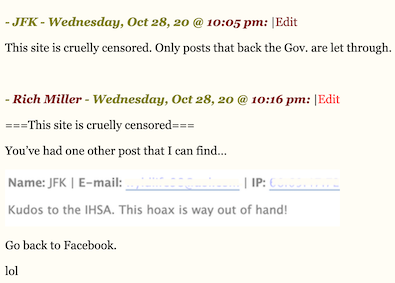
53 Comments  
|
It’s an old poll, but you might be interested
Thursday, Oct 29, 2020 - Posted by Rich Miller
* I do not for the life of me understand why people sit on numbers this long. The poll of 895 registered voters was taken September 26 through October 4. The surveys were conducted both on the phone and online. Margin of error was +/- 3.28 percentage points…
While Chicagoans share many concerns over the city’s policing practices, 79% want the police to spend the same amount of time or more in their neighborhoods. That’s one of the key findings of a new Wirepoints/Real Clear Opinion Research poll that looked at a range of attitudes in Chicago on policing, race and Mayor Lori Lightfoot’s performance.
The desire for more police holds true across the city’s North (76%), South (80%) and West Sides (85%), as well as across whites (79%), blacks (77%) and Hispanics (87%). Only 15% of blacks and 10% of Hispanics citywide said they want the police to spend less time in their neighborhoods.
The poll surveyed 895 registered voters in Chicago from September 26th through October 4th using a mixed phone and online methodology.
Over three-quarters (76%) of surveyed Chicagoans reported they strongly support or somewhat support Black Lives Matter. However, that support has not translated into a desire for cutting down the number of police or abolishing the Chicago Police Department (CPD). Instead, Chicagoans strongly indicate they want more and better-quality policing instead.
When asked directly if they supported defunding the police, over half (51%) of Chicagoans were opposed, with only 39% in favor. Among black residents, opposition (46%) to defunding slightly exceeded support (45%).
And while 26% of Chicagoans would be more likely to vote for city council members that support disbanding the police – a larger 37% would be less likely to vote for them.
“George Floyd’s death and the subsequent protests expanded the influence of Black Lives Matter across the country, including in Chicago,” says Ted Dabrowski, President of Wirepoints. “However, while a vast number of Chicagoans support BLM, a majority of residents – black, white and Hispanic – want more police in their neighborhoods.”
Those surveyed were also very clear in their desire for better-quality policing. Half (51%) of all Chicagoans polled said they believe the Chicago Police Department is currently handling its job badly. More than six out of ten black residents (63%) held that view.
Finally, the poll found that while Mayor Lori Lightfoot continues to hold a high overall approval rating (61%), her performance rating drops considerably on issues relating to race and public safety.
Some of the main poll results include:
• Nearly 80% of respondents wanted the police to spend the same amount of time or more in their neighborhoods. The desire for more police held true across the city’s North (76%), South (80%) and West Sides (85%), as well as across whites (79%), blacks (77%) and Hispanics (87%).
• Black Chicagoans are the most supportive of Black Lives Matter (86%), followed by whites (74%) and then Hispanics (61%).
• Only 39% of Chicagoans said they supported defunding the police, while 51% were opposed. Opposition to defunding exceeded support in the North, South and West Sides, with North Side residents expressing the most opposition (57% oppose/ 36% support)
• By race, whites and Hispanics were most opposed to politicians supporting disbanding the CPD, with 43% and 41% saying they would be less likely to vote for a council member that pushed disbanding, respectively.
• More than half of citizens from the North Side (54%) and the West Side (51%) said the CPD was doing a good or excellent job, while only 32% of voters from the South Side said the same.
• 61% of respondents approve of the job Mayor Lightfoot is doing. Chicago’s white residents gave her the highest marks (68%), followed by blacks (63%) and then Hispanics (48%).
• Lightfoot’s approval numbers drop on individual policy issues related to race and public safety: public safety (46%), racial justice (44%), police reform (39%) and gun violence (31%).
* The poll of Chicagoans found Gov. JB Pritzker’s job approval at 63 percent and disapproval at 31 percent, which is basically the same as Mayor Lightfoot’s. Toplines are here. Lightfoot is not doing well on budget and tax issues, either. Crosstabs are here.
16 Comments  
|
* Thoughts?…
*** UPDATE *** The governor has sent a letter in response…
Thank you for your October 28, 2020 letter regarding the impact of the second COVID-19 wave on independent businesses, especially restaurants. We agree that small businesses are the lifeblood of our economy and COVID is having a devastating impact on them and the entire economy.
The restrictions are necessary as cases, hospitalizations and deaths are rising and will not subside without mitigations. We are glad to have created the Business Interruption Grant (“BIG”) program to support small businesses through these difficult times. We have already expedited BIG grants to businesses affected by resurgence mitigations with $220 million available in the latest round. We have already distributed 1,900 grants to taverns and restaurants across the state and 630 of those grants in Chicago. Of those 630 Chicago grants, 195 were granted in your respective districts, totaling over $3.4 million dollars of direct state investment.
We have been a vocal and active in our advocacy for more support from the federal government directly to bars and restaurants. None of the Republican U.S. Representatives have indicated a willingness to support any new resources to support the impacts of COVID on bars and restaurants- let alone any other industry in Illinois.
Sincerely,
Governor JB Pritzker
18 Comments  
|
A tale of two counties
Thursday, Oct 29, 2020 - Posted by Rich Miller
* Christine Herman for NPR…
In Winnebago County, at the north end of the state, public health administrator Sandra Martell has been threatened with lawsuits from bar owners who want to continue to offer indoor service in violation of the governor’s orders for that region. At a press conference this week, she pleaded with businesses to spare her agency from spending precious resources trying to police the contentious mandate. […]
Sandra Martell faces a dilemma. She can order a bar closed, for example, but if law enforcement doesn’t back her up, nothing more will happen. And the local sheriff and local politicians have publicly encouraged businesses to defy the state’s orders. Meanwhile, COVID cases, hospitalizations and deaths continue to rise. Two hundred miles south, in Champaign County, public health administrator Julie Pryde’s experience is night and day.
JULIE PRYDE: This job is tough enough in doing it in Champaign, where I have a ton of support. I can’t imagine doing it where you’re fighting against your - the people in your community. It’s horrible. And we’re losing public health people all over the country. […]
The death rate in Champaign County is now less than a quarter of Winnebago’s.
* Meanwhile…
* Related…
* Libertyville mayor: We won’t enforce state ban on indoor dining
19 Comments  
|
* As subscribers have known for almost two weeks, Vote Yes for Fairness’ own polling has this nip and tuck. Here’s Dave McKinney and Tony Arnold…
Outside the presidential election, there arguably isn’t any bigger outcome Tuesday than whether Illinoisans vote to change the state constitution to set up a new way of taxing workers’ paychecks based on how much they make.
But there’s a debate now as to when voters actually will have an idea of whether their income taxes will change.
Thanks to a potential flood of uncounted mail-in ballots and Illinois’ latest-in-the-nation deadline to count them, one of Democratic Gov. JB Pritzker’s top political strategists said it likely will be well past Election Day before it’s clear whether the ballot question is a winner or loser.
“I think the odds are pretty high,” said Quentin Fulks, Pritzker’s former deputy campaign manager and chairman of the political committee pushing for the graduated income tax, Vote Yes for Fairness. “I’m anticipating probably a week to two weeks for us to know.” […]
Fulks says his committee’s polling shows the battle for changing the taxing structure in the state remains incredibly tight. Survey results his group released from mid-October found 55% of the Illinois electorate supported the graduated tax amendment, with 40% opposed.
…Adding… The antis think fears about a long wait are overblown…
“With historic numbers of voters turning out early, we anticipate clerks across the state will count the vast majority of these early ballots on Election Day, giving us a clear direction on the outcome of the tax hike amendment,” said Lissa Druss, a spokeswoman for the Coalition To Stop The Proposed Tax Hike Amendment.
45 Comments  
|
Open thread
Thursday, Oct 29, 2020 - Posted by Rich Miller
* Yeah? Well, I did things during the pandemic, too. Not like this. But things…
Keep it local, keep it polite. Thanks.
32 Comments  
|
|
Comments Off  
|
|
Comments Off  
|
|
 Support CapitolFax.com
Support CapitolFax.com
Visit our advertisers...

 ...............
...............
 ...............
...............
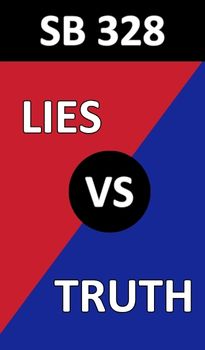 ...............
...............
 ...............
...............
 ...............
...............
 ...............
...............
 ...............
...............

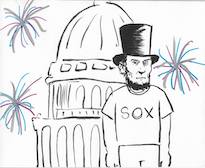
|
   
|
Hosted by MCS
SUBSCRIBE to Capitol Fax
Advertise Here
Mobile Version
Contact Rich Miller
|









